

Vienna Ringstrasse Walking Tour DIY (with Map and Tips)
After seeing Vienna’s exquisite landmarks, I can easily tell it has truly been a powerhouse of Europe. From its expansive palaces like Schönbrunn to magnificent churches like Karlskirche and spectacular museums like the Kunsthistorisches Museum , opulence is eternally present in the city.
In fact, even on Vienna’s streets, particularly on Ringstrasse , one can easily get lost in the grandeur of this beautiful imperial capital. Ringstrasse, also known as the Ring Road , is Vienna’s grand boulevard that encircles the city’s historic center. Built in the 1800s by Emperor Franz Joseph , it replaced the city’s old walls, allowing for a greater volume of traffic into the city center.
Today, some of the most beautiful buildings in the city stand on both sides of Ringstrasse . It is a slide of paradise for wanderers, photographers, and architecture enthusiasts.
Exploring Ringstrasse on foot is one of the most enjoyable free activities that you can do in Vienna. The map and itinerary that I will provide will help you make the most of it, should you wish to try this amazing activity.
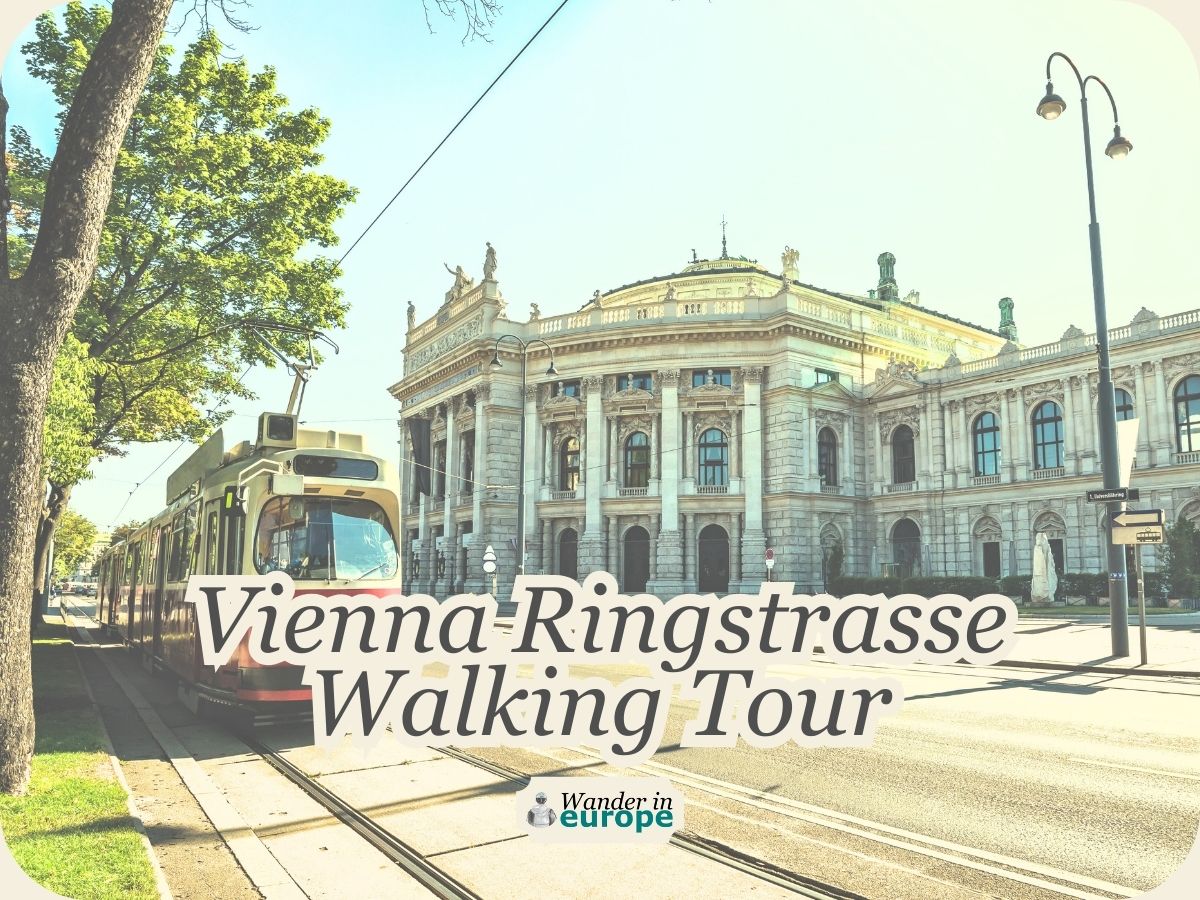
This post may contain affiliate links. I may receive a tiny commission at no additional cost to you from any qualifying purchases using the link.
Discover the secrets of Vienna with the help of a local and experts.
- Guided Tour of Ringstrasse (Great for group travelers)
- Vienna City Center Guided Tour (Best for solo travelers)
- 3-Hour Walking Tour of Vienna (Top pick of history lovers)
- Private Walking Tour of Vienna
What to Expect in Ringstrasse (Summary)
Most important of all: Although Ringstrasse in Vienna is home to some stunning buildings , it’s worth noting that they don’t line the entire 5.3-kilometer or 3.3-mile stretch of the boulevard. The beautiful structures aren’t continuous throughout Ringstrasse.
You’ll also find some unembellished modern structures along Ringstrasse , which, I believe, don’t quite fit the historical context . Keep this in mind and adjust your expectations accordingly to avoid disappointment. But rest assured, as you travel along most of Ringstrasse, you’ll be greeted by buildings that are mostly elegant and elaborate.
It’s good to know that Ringstrasse is lined with plenty of trees , providing a pleasant shade if you’re planning to explore the boulevard on foot during the summer.
Certain sections of Ringstrasse also have a bicycle lane , which is similarly shaded by trees. So, if you’re considering a quicker exploration of Ringstrasse by bike or Segway during a hot summer day, you won’t have to worry about overheating.
Did you know? Thousands of lime, hackberry, and Norwegian maple trees adorn Ringstrasse. Imagine the breathtaking sight of these trees complementing the beautiful architecture when it is a sunny autumn day in Vienna.
Another good thing to know: Some of the best parks and gardens in the city are accessible from Ringstrasse . These make for perfect spots to relax and enjoy some greenery during your walk
Keep in mind that Ringstrasse isn’t a pedestrian-only area . Being one of the main roads in Vienna, it sees a lot of traffic from cars, trams, and buses. Although they might contribute to the noise level, they also offer a convenient way to navigate Ringstrasse quickly , particularly if your time to explore its key attractions is limited.
Specifically, there’s a yellow tram , often referred to as the ‘sightseeing tram,’ that circles Ringstrasse. It provides a guided tour (not quite) lasting approximately half an hour, equipped with audiophones and an LED screen onboard.
As you go on your tour, I think you’ll come to agree with me on this point: When it comes to architectural styles, Ringstrasse doesn’t disappoint. You’ll find buildings designed in Renaissance, Gothic, Baroque, and even Classical styles . Some structures even showcase a blend of these styles!
Ringstrasse is sprinkled with hidden treasures like the monuments of Mozart and Johann Strauß. When you explore Ringstrasse on foot, you can stumble upon these delightful surprises, which is one of the perks of not using the tram.
If you want to catch all the little treasures of Ringstrasse, a tour led by a local guide could be great! Tour guides can provide fascinating insights about Ringstrasse that you might not find on any website .
But if you’re the type who likes to explore on your own, taking in the sights and capturing photos, the map later in this blog post will be a great help. It’ll guide you to the main attractions of Ringstrasse and some lesser-known treasures I found while wandering the boulevard.
Save to Pinterest
54 Things to See Along Ringstrasse
Following an exploration of Ringstrasse and a thorough examination of the maps, I came across more than fifty landmarks and attractions along this iconic route. These are places and objects that I believe are either architecturally impressive or historically important, and might catch the attention of travelers on their Ringstrasse tour.
Overall, there are 54 things to see in Ringstrasse . Eight of these — I consider architectural highlights. Ten are landmarks that I deem noteworthy. The rest, a total of 36, are lesser-known gems nestled along Ringstrasse and the adjacent parks.
Depending on your schedule and your interest in Vienna, it could be worth your while to check out each (or most) of these places on a walking tour along Ringstrasse. Let me give you a brief introduction to them. Their locations are shown in my maps of Ringstrasse .
8 Architectural Highlights of Ringstrasse
Not only are the architectural gems of Ringstrasse the most visually stunning landmarks along the boulevard, but they also hold a great deal of importance and symbolism in Vienna. If you’re putting together a must-see list for Ringstrasse, these eight attractions are, in my view, the ones you can’t afford to miss.
- Votivkirche : The Votivkirche stands as a symbol of gratitude for the survival of Emperor Franz Joseph from an assassination attempt. Its architecture is a striking example of Neo-Gothic style, boasting twin towers that stand 325 feet tall and intricate carved stonework.
- Rathaus : Serving as the city hall of Vienna, the Rathaus reflects the democratic governance of the city. It’s a grand structure stretching over 100 meters in length along Marienplatz, topped by an 85-meter-tall tower, all in the Neo-Gothic style.
- Burgtheater : Also known as “die Burg” by the Viennese population, the Burgtheater is Austria’s national theater and one of the most important theaters in the world. The building is filled with sweeping staircases, ornate marble archways, stone carvings, oil paintings, and glorious ceilings.
- Austrian Parliament Building : The Austrian Parliament Building is a beacon of democracy, serving as the meeting place for the two houses of the Austrian Parliament. Designed by Theophil Hansen, the building is a masterpiece of Greek Revival style, complete with many columns, a triangular pediment, and countless statues.
- Naturhistorisches Museum : The Naturhistorisches Museum showcases the diversity of nature, the evolution of Planet Earth and life, and the related cultural development of humankind. The museum building is filled with sweeping staircases, ornate marble archways, stone carvings, oil paintings, and glorious ceilings.
- Kunsthistorisches Museum : The Kunsthistorisches Museum houses an extensive collection of international art, making it one of the most important art museums in the world. The building itself is a magnificent neo-Renaissance structure commissioned by Emperor Franz Joseph I and opened in 1891.
- Hofburg : The Hofburg, the former principal imperial palace in the center of Vienna, has housed some of the most powerful people in Austrian history, including the Habsburg dynasty, rulers of the Austro-Hungarian Empire. It currently serves as the official residence of the President of Austria and showcases various architectural styles, from Gothic to Renaissance, Baroque, Rococo, and Classicism.
- Vienna State Opera : The Vienna State Opera is one of the top opera addresses in the world, offering a different program every day, with over 50 operas and ballet works on around 300 days per season. The building itself, opened in 1869, is a masterpiece of the Neo-Renaissance style, with elaborate stone and wood carvings, frescoes, and gold leaf ornamentation.
10 Other Notable Landmarks in Ringstrasse
Ringstrasse is also lined with commercial establishments and educational institutions housed within architectural masterpieces. In fact, you can also find palaces here! These, along with other government offices and historical landmarks, are worth a stop during a walking tour along Ringstrasse to ensure a more awe-inspiring tour along the boulevard.
If you have time, you can enter some of these other notable landmarks in Ringstrasse and see more impressive architecture.
- Palais Hansen : Palais Hansen is a historicist building that was built in 1873 by Theophil Hansen for the Vienna World’s Exhibition. It is one of the most magnificent historicist buildings on Vienna’s famous Ringstrasse. The building was designed in the Renaissance revival style and is now used as a luxury hotel.
- Alte Börse : The Alte Börse, also known as the Old Exchange, is the oldest assembly building of merchants in Leipzig, Saxony, Germany. It was built in 1678 and is the city’s oldest Baroque building. The building was designed by Johann Georg Starcke, a master builder at the court of John George II, Elector of Saxony, in Dresden.
- Hotel de France : The Hotel de France is a grand structure located in Paris, showcasing the glory of the Rococo architectural style. It is known for its ivory white color and is considered a significant monument in Paris.
- University of Vienna : The main building of the University of Vienna, located on the Ringstrasse, was opened in 1884. The building was designed in the Historicist style, modeled on idealized versions of historical architectural styles but adapted to the technological and functional demands of the time in which it was built. The building represents the self-conception of a deterministic view of science, promising a “victory of light against darkness”.
- Justizpalast : The Justizpalast, or Palace of Justice, is the seat of the Supreme Court of Austria. The Neo-Renaissance building was erected from 1875 to 1881 and is located in Vienna on Schmerlingplatz, a square near the Ringstraße boulevard in the central district of Innere Stadt.
- Grand Hotel Wien : The Grand Hotel Wien is a historicist building that was built in 1873 by Anton Schneider. It was designed in the Renaissance revival style by Carl Tietz and is now used as a luxury hotel.
- Hotel Imperial, Vienna : The Hotel Imperial, also known as The Imperial, is a five-star luxury hotel in Vienna, Austria. It is located on the Vienna Ring Road at Kärntner Ring 16, in the Innere Stadt district. The Hotel Imperial’s façade is in the Italian Neo-Renaissance style.
- Kursalon : The Kursalon is a music hall in Vienna, designed by Johann Garben in the style of the Italian Renaissance and built between 1865 and 1867.
- Museum of Applied Arts : The Museum of Applied Arts is a masterpiece of Hungarian Art Nouveau, built between 1893 and 1896 to plans by Ödön Lechner and Gyula Pártos.
- Building of Federal Ministry of Social Affairs, Health, Care and Consumer Protection : Is a historical building in Vienna, notable for its neo-classist design that is adorned with different symbolisms.
36 ‘Little Gems’ & Lesser-Known Attractions Along Ringstrasse
Walking around Ringstrasse, you’re bound to discover little treasures scattered throughout Vienna. These could be historical monuments, remnants of bygone eras, charming fountains, or striking artworks that are just begging to be photographed.
You’ll find most of these gems nestled within the city’s green spaces. Some are situated next to larger, well-known landmarks, while others are right there in the middle of the street, easy to spot.
My top picks among these are the Maria Theresa Monument, situated between the Naturhistorisches and Kunsthistorisches museums, and the Prince Eugene Monument at Heldenplatz. Their intricate details and the picturesque backdrop of nearby buildings make them stand out. Also, don’t miss the Minervabrunnen by the Museum of Applied Arts. I personally think it’s the most captivating fountain in Vienna.
Map of Ringstrasse: Attractions & Landmarks
You might be curious about the exact locations of the architectural marvels, significant buildings, hidden gems, or even the Ringstrasse itself in Vienna. The maps provided should help you pinpoint their locations in the city.
Imagine you’re at Stephansdom. You can reach Ringstrasse on foot in about 10 to 15 minutes, regardless of the direction you take. If you decide to use public transportation, the journey is only a couple of minutes.
Segments of Ringstrasse Map
Before you start exploring Ringstrasse, it’s important to know that it’s divided into different sections, each with its own name. The landmarks along Ringstrasse use these section names in their addresses. For instance, the Vienna State Opera is located at ‘Opernring 2, 1010 Wien’.
If you’re not a fan of using smartphones for navigation, knowing these street segment names and their sequence can give you an advantage when finding your way around Ringstrasse. You’ll typically find the names of the street segments displayed on dark blue signs mounted on street posts.
Architectural Highlights of Ringstrasse Map
If your plan is to focus on the architectural highlights along Ringstrasse, you’ll only be exploring four key segments: Universitätsring, Dr.-Karl-Renner-Ring, Burgring, and Opernring.
It’s a 30-minute walk from Votivkirche to Vienna State Opera, and that’s without stopping. Depending on your pace for sightseeing, snapping photos, and resting, I’d recommend setting aside at least 2 hours. This time estimate includes brief stops at parks and other notable landmarks along these four sections of Ringstrasse.
Other Notable Buildings Along Ringstrasse Map
Suppose you have half a day or four hours and you’re in the mood for a ‘wandering spree’ in Vienna. In that case, you might be able to take in all the significant buildings and architectural gems of Ringstrasse.
From Palais Hansen to the Building of Federal Ministry of Social Affairs, it’s a direct one-hour walk. The other three hours can be used for brief rests, photo ops, and a quick look at some of the landmarks and parks along Ringstrasse.
Little Gems Along Ringstrasse Map
Should you wish to see the majority of Ringstrasse, including the small gems, you might need to set aside an entire day. I would suggest this only if you have additional time to spend in Vienna.
There are other worthwhile attractions in Vienna that aren’t located along Ringstrasse, and I believe you’ll enjoy visiting them. Don’t miss out on Belvedere Palace , which is also a short walk from this section of Ringstrasse.
Map of Ringstrasse (All Parts & Attractions Highlighted)
The map above provides the full picture of the locations of the attractions along Ringstrasse.
The red highlights point out the architectural marvels , while the blue ones mark the notable landmarks . The locations marked with violet arrows and numbers represent the little gems you can discover there, indicating both their location and quantity.
Ringstrasse Walking Tour Itinerary
Whether you’re a casual tourist or an avid explorer, I recommend setting aside half a day (at most) to explore Ringstrasse , especially since there are other places in Vienna where it is recommended to spend more time at.
For a walking tour, it’s a great idea to cover the entire length of Ringstrasse ( excluding the part of Schottenring that runs along the Danube Cana l). But if it’s your first time in Vienna, focusing on the architectural highlights, notable buildings, and hidden gems within these four segments of Ringstrasse should be enough: Universitätsring, Dr.-Karl-Renner-Ring, Burgring, and Opernring . It should also be more practical.
As for when to start exploring, that’s up to you. But if you’re into photography , you might want to start your Ringstrasse walking tour three or four hours before sunset . That way, you can take advantage of the golden hour, which makes the city’s architectural landmarks look even more dramatic.
I suggest starting your walking tour of Ringstrasse at the Vienna State Opera and ending it at Votivkirche , which I think is one of the best places to watch the sunset in Vienna. The gothic spires and flying buttresses of Votivkirche, bathed in the warm light of the setting sun, are truly a sight to behold.
Now, let me give you an itinerary based on my recommendations. This itinerary focuses on sightseeing. You’ll get a chance to see the interiors of some of the landmarks, but we’ll save exploring the exhibits inside the museums housed within beautiful buildings for another part of the day.
First Stop: Vienna State Opera
Let’s start our walking tour at the Vienna State Opera. No matter where you are in the city, it’s easy to get to. There are bus, tram, and underground train stops (Oper, Karlsplatz), just a few steps from the entrance.
As one of the most important opera houses in the world and a masterpiece of Neo-Renaissance architecture , it’s a must-see on your walking tour of the Ringstrasse.
Did you know that the Vienna State Opera has the largest repertoire in the world ? It presents around 350 performances of over 60 different opera and ballet works each season. Plus, the orchestra of the Vienna State Opera is none other than the world-renowned Vienna Philharmonic .
Talking about the architecture: The interiors of the opera house are richly decorated and a feast for the eyes. From the grand staircase to the Schwind Foyer and the Auditorium , there’s so much to see.
If you like, since the Vienna State Opera is the first stop of this Ringstrasse walking tour, you can tour the interiors of the opera before you really start exploring Ringstrasse.
Vienna State Opera offers guided tours that last about 40 minutes. You’ll get to see the foyer, the Grand Staircase, and the ceremonial rooms. You’ll also get a view of the auditorium from the stage. It’s a great way to learn about the history and architecture of the opera house.
For more information, the link to the official website of Vienna State Opera is linked at the resources section of this post.
You don’t need to enter the Vienna State Opera to get impressed by its architecture, though. Its exteriors are already noteworthy.
Take note of the Equestrian Statues above the main entrance, representing Harmony and the Muse of Poetry. Also, check out the intriguing allegorical fountains on each side of the opera house.
On the right side, you’ll find the fountain with the statue of the Siren, Lorelei, supported by sculptures representing love, grief, and revenge. On the other side, you’ll find the fountain that illustrates dance, music, and joy — the very things an opera house brings to its visitors.
Second Stop: Burggarten
Next on your walking tour of Ringstrasse is Burggarten . It’s just a three-minute walk from the Vienna State Opera, across one block and Operngasse . Once part of the glacis in front of the Vienna City Wall, Burggarten is now one of Vienna’s most charming parks.
Burggarten is a wonderful stop on your walking tour because it is not just beautiful with its picturesque views of the rear facade of Hofburg’s Neue Burg, but it’s also home to monuments of some of Austria’s most celebrated personalities.
You’ll find tributes to Mozart, Franz Stephen, and Franz Joseph right here in this garden. Be sure to check out the Mozart monument, which features a giant G Clef garden art in front.
Actually, just before you get to Burggarten from the Vienna State Opera, you’ll come across the monument of Goethe . This monument depicts a significant figure in the empire’s history – a renowned 18th-century German poet and writer. His most famous work, the novel ‘Faust,’ is considered one of the greatest pieces of world literature.
You see, a visit to Burggarten is like a brief journey through Austria’s rich heritage and history. And there’s more!
Occasionally, you might even spot a few Lipizzaner horses from the Spanish Riding School wandering around Burggarten. The tradition of breeding these horses is recognized as a UNESCO Intangible Cultural Heritage.
In Burggarten, you’ll also find a beautiful fountain called the Hercules Fountain . It’s an excellent place to snap some photos, particularly with the beautiful reflections of the statue on the water. What’s remarkable about this statue is that it was crafted as far back as 1770, but it wasn’t until 1948 that it was placed in the middle of the pond
Third Stop: Heldenplatz
From Burggarten, head over to Heldenplatz . This is the square situated in front of the Neue Burg, or the New Castle, of the Imperial Palace, also known as Hofburg.
You’ll find it’s only a minute’s walk from Mozart’s Monument in Burggarten if you take the path along Burgring.
To me, Heldenplatz is another one of the most picturesque squares in the city , thanks to the facade of Neue Burg covering the entire southeast perimeter of the square. On this square, you’ll see why Hofburg is an architectural highlight of a walking tour along Ringstrasse.
In Heldenplatz, you can also find the statue of Prince Eugene —a successful military leader who fought against the Ottomans during the Siege of Vienna. You can photograph his statue with Neue Burg in the backdrop for an epic shot.
Across from the monument of Prince Eugene, you’ll find the Equestrian statue of Archduke Karl . It’s as if he’s poised to engage Prince Eugene in battle.
This particular statue in Vienna always reminds me of the painting ‘ Napoleon Crossing the Alps ’. The reason being the way the Archduke is depicted in his position on the horse, with two of its feet raised in the air. I would venture to guess that the statue of Archduke Karl was designed in such a manner due to his significant role during the Napoleonic Wars.
Speaking of the Napoleonic Wars, the triumphal arch that you’ll see on the western side of Heldenplatz (the one near Burgring), was built to commemorate the Austrian victories over Napoleon.
Some call it the Heroes Monument , in honor of the veterans of the Napoleonic wars. However, it is also called the Outer Castle Gate , being a remnant of the fortification walls that were dismantled to be replaced by Ringstrasse.
Under the arches of the Outer Castle Gate, you can get a picturesque view of Hofburg, framed by the columns of the edifice.
On the other side of the Outer Castle Gate, you’ll then see the city’s two impressive palatial museums: The Kunsthistorisches and Naturhistorisches Museum.
For those who appreciate historical art pieces, intriguing displays, and grand collections, investing more time in the Kunsthistorisches Museum and the museums inside Hofburg is a must. Especially when the weather doesn’t permit a stroll around Ringstrase, these Vienna attractions will surely fascinate you. The Military History Museum is another noteworthy museum, a must-see for travelers interested in history, stories of war, and weapons.
Links open in a new tab.
Fourth Stop: Volksgarten
To me, among the gardens in Vienna, Volksgarten is the most well-designed, well-maintained, and picturesque that is not a part of a palace . It’s located just beside Heldenplatz . You won’t have any trouble looking for Volksgarten during your walking tour of Ringstrasse.
If you’re planning a summer visit, the sight of flowers blooming everywhere is sure to make you smile. When I explored the garden, I was struck by the variety of roses, each one a different color! There are plenty of benches under shady trees, too, perfect for a quick break or even a picnic.
Sure to catch your eye as you wander within Volksgarten is the Theseustempel . This Greek-style temple, in the heart of the garden, is begging to be photographed with the surrounding flowers and plants.
Theseustempel houses unique art exhibits. If you have the opportunity to visit during its opening hours, I suggest you do so. The last time I checked, there was a fascinating temporary exhibition called “Bottled Ocean,” which was a representation of the ocean made entirely of plastic pieces.
Apart from Theseustempel, another element that adds to the picturesque quality of Volksgarten is the architectural highlights of Ringstrasse that surround it.
From the garden, you can spot the Hofburg, Naturhistorisches Museum, Burgtheater, Austrian Parliament, and even the Rathaus ! Their majestic domes and spires peek over the trees of the Volksgarten. Because of these landmarks, it seems that every spot in the Volksgarten is a photo opportunity.
My favorite scene is on the southwestern side of the park, where you can photograph the Franz Grillparzer Monument with the roof and dome of the Naturhistorisches Museum in the background.
Make sure you also visit the beautiful flower beds that run parallel to Ringstrasse, and then face north. From there, you can see the majestic Burgtheater , perfectly aligned with the design of the flowerbed .
If you’re an architecture enthusiast, I’m sure you’ll hear the Burgtheater whispering this inside your head: “Come closer and see my beauty!” Well, don’t hesitate. The Burgtheater is one of the buildings you’ll see in Vienna with stunning exteriors!
If the north gate of the Volksgarten is open, you can use it to get closer to the Burgtheater and appreciate its architecture up close. However, the best view of the Burgtheater is located in Rathausplatz , which is another stop on this Ringstrasse walking tour.
Fifth Stop: Austrian Parliament and Justizpalast
Across Universitätsring from Volksgarten, you’ll find the Austrian Parliament Building and Justizpalast , another architectural highlight and notable landmark in Vienna along Ringstrasse.
On this part of the Ringstrasse walking tour, you’ll encounter numerous photo opportunities. However, it’s important not to miss appreciating their architecture, which is both imposing and symbolic .
I recommend visiting the Justizpalast first, then the Austrian Parliament Building for a seamless route to the next parts of this walking tour. There’s a pedestrian lane crossing Burgring near the long parking lot between Heldenplatz and Volksgarten; please use it to get to the Justizpalast . After crossing the road, walk northward towards the Austrian Parliament.
Before you reach the Austrian Parliament Building, you’ll find Grete-Rehor Park, where the Republic Monument is located. This monument was unveiled on the 10th anniversary of the Republic in 1928, but it remained a highly controversial symbol of the country’s antagonistic political camps and the profound ideological conflicts within its society.
On the opposite side of the park, you can find the Justizpalast. Built between 1875 and 1881, it’s a masterpiece of Neo-Renaissance architecture . Its elegant facade, elaborated with statues of lions and personified values, should inspire you to take photos by the time you emerge from the park near the circular flower bed .
Good to know : You can actually go inside and see it for yourself! You can marvel at the arcade court, the stunning ceilings of the colonnades, and the side corridors. When you step inside, you’re greeted by a grand staircase in the entrance hall, leading up to a statue of Justice.
Entry to the Justizpalast requires a security check and is only allowed from Monday to Friday, 7:30 am until 3:30 pm.
The Austrian Parliament Building is just a few steps away from the Justizpalast. The best view is in front of the building , where you can fully behold its imposing grandeur. It’s designed in the style of Greek Classicism by Theophil Hansen.
Why Greek, you ask? Well, it’s a nod to ancient Greece, where democracy was born.
It’s also good to know that you can enter the Austrian Parliament Building for free on a guided tour . It’s even more impressive inside. You’ll see elegant architecture and exhibits relating to Austria’s government. Everything that you’ll see will make you realize that Western culture truly flourishes in Austria.
Sixth Stop: Rathausplatz
Strolling northwards from the Austrian Parliament Building, you’ll reach Rathausplatz , another beautiful square in Vienna. Thanks to the City Hall , or Rathaus, which dominates the view of this park, it’s a place you can’t leave without taking a photo.
You’ll recognize the picturesque quality of Rathausplatz when you stand in the middle of the park’s two gardens.
Face west, and you’ll see the towering Gothic facade of the Rathaus . Turn around, and you’ll find the gorgeous Burgtheater . In between are detailed statues and monuments of some of the most important figures in Austria’s history.
Explore the gardens, and more artistic landmarks await you, such as the Giarolli Weather Station, Strauss-Lanner Monument, and Doctor Karl Renner Monument .
If you’re still planning your trip to Vienna, it might be a good idea to check the city’s calendar of events . They may give you an idea of when to have this walking tour of Ringstrasse. Why? Because Rathausplatz is the most popular site for open-air festivals and usually has something going on, especially in summer and winter.
There’s the Rathaus Film Festival, Christmas Market, and Vienna Ice World . There could also be a large gastronomic section in Rathausplatz during these events. A wide range of culinary delights could be awaiting you here. It’s an opportunity to make the most of your walking tour!
You shouldn’t feel bad if your desired travel date to Vienna does not coincide with the days when events take place in Rathausplatz.
The architecture of the Rathaus and Burgtheater is already a visual delight. The Vienna Rathaus, or City Hall, is a beautiful example of neo-Gothic architecture .
It was designed by Friedrich von Schmidt and completed in 1883. The design of the richly adorned facade is modeled on the Gothic architecture of Flemish and Brabant secular buildings, similar to Brussels’ Town Hall.
The Burgtheater, where three Mozart operas premiered, on the other hand, is a stunning example of Neo-Renaissance style architecture . Its beautiful proportion and symmetry , from the use of classical elements such as columns, pilasters, and pediments, make it irresistible to behold and photograph, especially during the golden hour.
Seventh Stop: University of Vienna
Strolling further north from the Rathaus, you’ll stumble upon one of the most beautiful educational institutions in Austria, the University of Vienna .
One glance at even a part of its main building and you’ll definitely feel the urge to explore… or even consider studying here!
Architecturally speaking, the University of Vienna is a prime example of the Historicist style of architecture , popular in the mid-19th century. The design of the university is characterized by elements borrowed from various historical periods and regions, combined to create a harmonious whole.
Similar to the Austrian Parliament Building, the front facade of the main building of the university is dominated by a large portico, inspired by Greek architecture . And the reliefs and sculptures adorning the windows on the 3rd floor of the university will keep you walking, circling the entire perimeter of the building.
Wanderers, wait until you reach Reichsratstrasse at the rear side of the main building. From that street, you can see the wall of the main building of the university, adorned with artworks (not sure if they’re mosaics or just paintings) that tell different stories.
If you are interested in learning more about the University of Vienna, you can join a guided tour which will also let you explore the interiors of the campus. For more information, you can check the official website of the University of Vienna in the resources section of this post.
Fun fact! Another reasons why I think the University of Vienna is a must-see during a walking tour of Ringstrasse is that this university is one of the oldest universities in the German-speaking world . Believe it or not, it dates back to 1365 ! Imagine the privilege of seeing such a timeless educational institution.
Eight Stop: Votivkirche
We conclude your Ringstrasse walking tour at Votivkirche , which is undoubtedly one of Vienna’s most majestic churches . This 19th-century church is only a few steps from the University of Vienna and it should take your breath away even before you leave the university’s surrounding area.
Especially on a bright sunny day, Votivkirche is a sight to behold. This neo-Gothic-style church punctures the sky with its intricate stonework-adorned spires . You’ll surely be drawn closer to it once your eyes meet its angelic beauty.
From the ground, you’ll be staring at a 99-meter-tall architectural marvel for minutes!
Taking in the view and capturing photographs of Votivkirche from the Ringstrasse side or Sigmund Freud Park (the park in front of Votivkirche) may already feel like a satisfying experience. However, you must not forget to wander around the church— you must see the outer part of Votivkirche’s choir .
The flying buttresses, ornate pinnacles, and gargoyle stoneworks are simply marvelous.
Another interesting aspect of Votivkirche is its history, aside from its awe-inspiring appearance. Did you know that Votivkirche was built all because of a dramatic event? Its origins can be traced back to 1853 when Emperor Franz Joseph survived an assassination attempt .
The would-be assassin, János Libényi, attacked the Emperor with a knife, but the Emperor’s heavy gold collar saved his life by deflecting the blow. In gratitude for his brother’s survival, Archduke Ferdinand Maximilian initiated a campaign to build a church on the site of the attack.
This church was intended as a votive offering, a symbol of thanks to God for sparing the Emperor’s life . The construction of the Votivkirche took 26 years, and the church was finally consecrated in 1879, coinciding with the silver wedding anniversary of Emperor Franz Joseph and his wife, Empress Elisabeth.
Besides the Votivkirche, Karlskirche, and Stephansdom that were previously mentioned, there’s one more church in Vienna that should be on your itinerary if you love wandering in stunning religious sites. This is Peterskirche, a Baroque masterpiece located in the city’s historic Old Town. See how beautiful Peterskirche now .
Resources: Vienna Ringstrasse
And there you have it – a comprehensive walking tour of Ringstrasse, showcasing its architectural marvels and other must-see spots.
To help with your future planning, do check out the official website of the Vienna tourism board . It offers news, announcements, and a calendar of events that can make your travel experience even better. For more information about the places we’ve discussed, feel free to explore their official websites.
- Official website of the University of Vienna (self guided and guided tours)
- Official website of Vienna State Opera (guided tour more information)
- Official website of Austrian Parliament (guided tour more information)
Haven’t secured a place to stay in Vienna yet? If this article has been of help, please consider making your hotel reservations through my partner website . They have some of the best hotel deals not just in Vienna, but all over Europe. Plus, every booking made through them gives me a commission, without any additional charges on your end. This aids in maintaining this site and producing more helpful content like this. Your assistance would mean a lot!
Wondering where to head after your exploration of Ringstrasse?
Set your sights on the Danube Tower . It’s not just the tallest structure in Vienna, but in all of Austria. From its heights, you can get a bird’s eye view of the landmarks you’ve visited during your Ringstrasse walking tour.
Planning a visit to Vienna for three days or perhaps a week?
There’s so much more to explore beyond the city’s impressive architectural wonders and fascinating historical sites. Consider taking a day trip to other stunning locations in Austria !
Within a day, you can experience some of the country’s most breathtaking places. These include Salzburg , Melk Abbey , and the enchanting destinations in Salzkammergut such as St. Gilgen and Hallstatt.
If you prefer to stay closer to the city, the castles in Lower Austria make for excellent alternatives. Don’t miss out on these three: Laxenburg Castle Park , Liechtenstein Castle , and Kreuzenstein Castle .
Leave a Reply Cancel reply
Your email address will not be published. Required fields are marked *
Save my name, email, and website in this browser for the next time I comment.

Vienna Sightseeing Walk Ringstrasse
Just click on the image below to open the free PDF map!
The map with the sightseeing walk is ideal for printing or to save it directly on your smartphone.
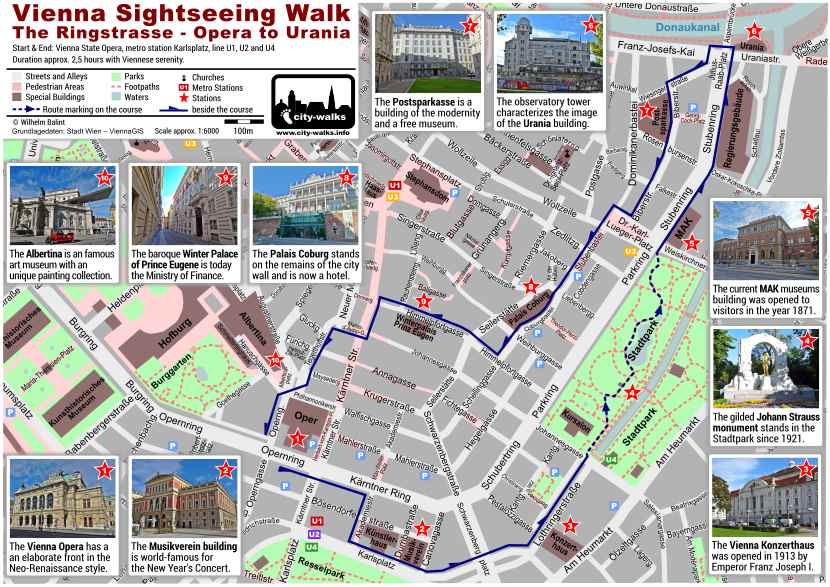
Viennese Ringstrasse - Ring Road
The Viennese Ringstrasse surrounds circular the 1st district in the center of Vienna . The multi-lane street was built as a boulevard instead of the demolished city wall in the middle of the 19th century . The emperor at that time, Franz Joseph I. , gave the order for this. As a result, many new magnificent buildings were built around the Ringstrasse .
This sightseeing walk takes you along the eastern part of the Ringstrasse from the Vienna State Opera to the Urania building . The route runs only on some parts directly on the Ringstrasse . Most of the time it runs parallel to the Ringstrasse to show you the most beautiful places in the area.
Due to the length of the Ringstrasse , this walk does not cover the entire Ring Road . If you want to discover the well-known buildings of the western area , then you should have a look on another walk, the Walking Tour City Center . This walk is the right choice if you like to see the Hofburg , the Town Hall or the Parliament on the Ringstrasse.
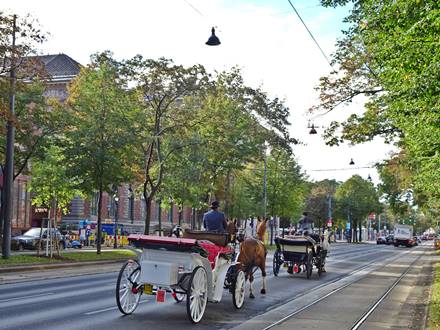
Viennese Ring Road with Fiaker carriage
Stations of the Walk
The construction of Vienna Opera House was completed in the year 1869 . Unfortunately, parts of the building were destroyed by a bomb hit during an air strike against Vienna in the World War II . The front facade , however, remained intact . You can still see the original facade in the Renaissance arch style from the 19th century . The house is not only famous for its opera performances , but also for the annual Opera Ball and the orchestra . In order to be accepted by the famous Vienna Philharmonic , one must have played in the orchestra of the State Opera for at least 3 years .
Vienna State Opera
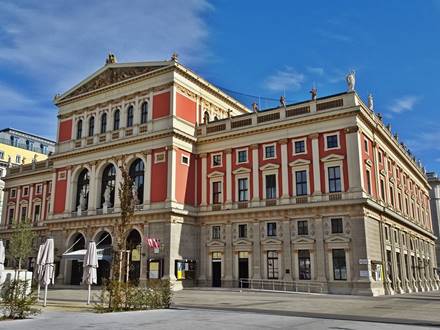
Musikverein Building
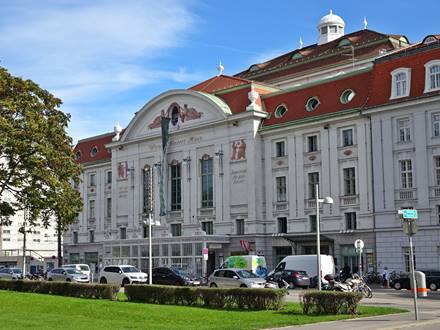
Viennese Concert House
The opening of the Musikverein building was in 1870 , one year after the State Opera opening . The concert house is one of the magnificent buildings near the Ringstrasse and is certainly one of the most beautiful concert houses in the world . It was constructed in the Greek Renaissance style . The architect Theophil Hansen was born in Denmark and studied in Greece for several years. The Golden Hall in the building is a unique concert hall and is famous for the New Year's Concert of the Vienna Philharmonic Orchestra , which is watched by over 50 million viewers worldwide.
The Viennese Concert House was ceremoniously opened in the year 1913 . As like with many other buildings around the Ringstrasse, Emperor Franz Joseph I. was present at the opening. Just like at that times, the Concert House is still the main venue of the Vienna Symphony Orchestra and a popular house for international orchestras and well-known jazz stars . Among the 4 concert halls, the Great Hall is particularly noteworthy. It provides an impressive scenery for a special musical experience .
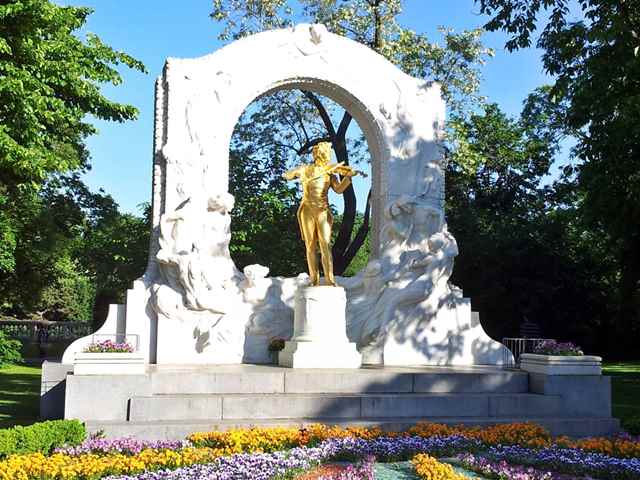
Johann Strauss Monument
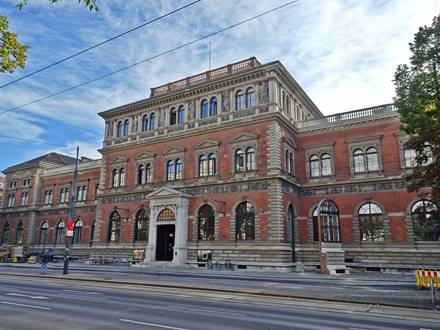
MAK - Museum of Applied Arts
The Johann Strauss monument in the Stadtpark was erected in 1921 . The Vienna Philharmonic Orchestra played at the unveiling ceremony . The gilded bronze statue is an eye-catcher and certainly the most popular photo motif in the Stadtpark . The park is located between the Ringstrasse and the river Wienfluss . It is a well-attended green oasis in the center of the city. Many Viennese relax here in their leisure time. The numerous benches are perfect for a short break during your walk. Take the opportunity and experience personally the typical Viennese serenity .
The MAK - Museum of Applied Arts was founded in the year 1863 . The building on the Ringstrasse was constructed for this museum and opened in 1871 . It was the first building for a museum on the new Ringstrasse and it was erected in the Renaissance style . The model for the museum was the predecessor of today's Victoria and Albert Museum in London. Today the museum focuses on design , architecture and contemporary art . The collection on display includes glasses, carpets, furniture and graphics from various periods of art history.
The Urania building was built in Neo-Baroque style and the opening was in the year 1910 . The tower with an observatory at the top characterizes the appearance of the building. Originally, the premises were mainly used for scientific lectures to the general public. Today there is an observatory , a cinema , a puppet theater and a restaurant with a roof terrace directly above the Danube Canal.
The building of the Austrian Postal Savings Bank is one of the most important Viennese buildings in Art Nouveau style . It was designed by the well-known architect Otto Wagner and completed in 1912 and at that time it was a very modern construction . Otto Wagner's motto was: What is impractical can never be beautiful! This guiding principle was also applied on the design of the entire interior . You should just see it for yourself! Some rooms in the building are accessible as a museum with free admission . Usually open Monday to Friday from 10:00 to 17:00 .
Austrian Postal Savings Bank
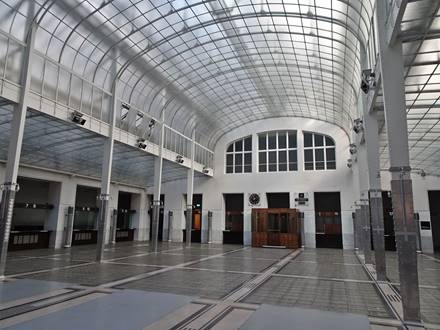
Big Cash Hall Postal Savings Bank
The Palais Coburg was built between 1840 and 1845 and towered originally over the city walls of Vienna . The numerous narrow columns in the front inspired the people in Vienna to call it the Asparagus Castle . Over time, the palace has had numerous functions and is today a noble hotel .
The Winter Palace of Prince Eugene is located in a long and narrow alley with the name Himmelpfortgasse . Prince Eugene was a famous general who led the Habsburg army in numerous battles like in the Great Turkish War . From the end of the 17th century , Prinz Eugen had a representative accommodation in the city with this winter palace. In the summer time he lived usually in the famous Belvedere Palace . Today the Ministry of Finance is located in the Winter Palace of Prinz Eugen.
The Albertina is an important art museum in Austria and houses a world-famous collection of paintings with works by Pablo Picasso , Claude Monet , Marc Chagall ... The building of the Albertina is the Palais Erzherzog Albrecht . The originally name of the palace was Taroucca and it was built from 1742 to 1745 . The palace is constructed on the remains of the Augustinerbastei , which was formerly part of the city's fortification complex .
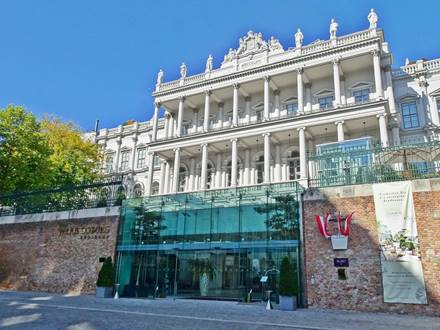
Palais Coburg
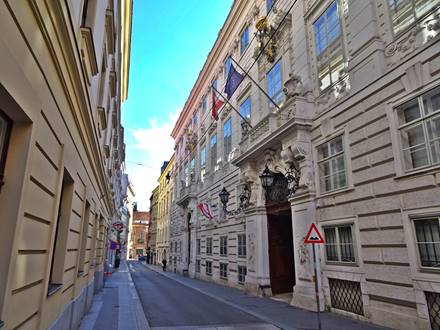
Winter Palace of Prince Eugene
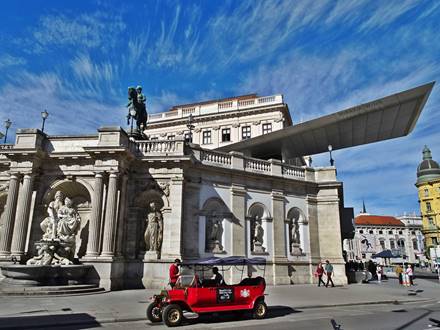
Albertina Museum
Details about the Walk
Start: The sightseeing walk starts in front of the Opera House at the Opernring, which is part of Vienna's Ringstrasse . The nearest metro station, Karlsplatz , is about 200 meters away and is quite easy to reach . The metro lines U1 , U2 and U4 stop directly there.
Route: Since there is all the time a lot of traffic on the multi-lane road of the Ringstrasse, the route runs only for short sections directly on it. In most cases, the route goes parallel to the Ringstrasse and leads to the most important buildings and popular places around the eastern section of the Ringstrasse . The walk is perfect for sightseeing and you will see narrow alleys , a green park and many impressive squares along the route.
Duration: With Viennese serenity , the entire walk takes about 2,5 hours .
Tourist Map
Maps of the center for orientation and travel planning ...
Attractions
The top attractions in the center of Vienna with info and tips ...
Walking Tour
Route and description for a inspiring walk through the inner city ...
Cheap Hotels
Do you want to book a hotel with a good price, situated in the center ...
Facts and figures about the city, tips for your journey and stay ...
Food & Drink
Recommendations for restaurants, cafes, bars and ice cream shops ...
The imperial spa town Baden is located only 25 km in the south of ...
Travel Guide
Overview of all the city-walks topics from which you can choose ...
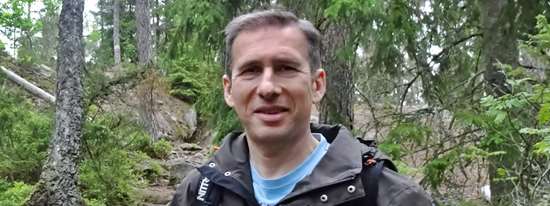
About city-walks.info:
Hello, my name is Wilhelm Balint . I am the author of this web page and the face behind city-walks.info . I love to experience the unique atmosphere of a city during a walk . Whether crowded tourist attractions or hidden sights , every place can look beautiful with the right viewpoint! city-walks.info should help you with tips and useful information to discover these beautiful views of the city. Read more ...
Imprint - Privacy © Wilhelm Balint

All About Vienna
Travel guides, attractions and tips
The Magnificent Ringstrasse: Your Ultimate Guide to Exploring Vienna Ring Road

ADDRESS & CONTACT
Vienna Schubertring
48.2017218, 16.3746223
OPENING HOURS
Welcome to the enchanting city of Vienna, where history and grandeur intertwine along a magnificent boulevard known as the Vienna Ring Road – Ringstrasse. This iconic ring road, encircling the heart of Austria’s capital, is not just any ordinary street – it is a living testament to Vienna’s rich past and enduring charm. From stunning architectural marvels to cultural treasures that will leave you in awe, the Ringstrasse invites you on an unforgettable journey through time and beauty. So fasten your seatbelts as we embark on our ultimate guide to exploring Vienna’s mesmerizing Ringstrasse!
In addition to its stunning architectural feats, the Ringstrasse also offers its visitors plenty of opportunities for leisurely strolls along its tree-lined boulevards or coffee breaks at one of its traditional cafes. Here you can pause for a while and observe Viennese people going about their daily lives – from children playing on playgrounds to couples dancing in ballrooms – it’s all here for your enjoyment! From sightseeing opportunities to cultural attractions to recreational activities – there is something for everyone along the beautiful Ringstrasse.
Table of Contents
The Ring Road info
The Ringstrasse is a 5.3 kilometer (3.3 mile) long circular road that completely encircles the city center of Vienna. Built in the mid-19th century, this grand boulevard replaced and was designed to replace the old city walls, giving Vienna its modern appearance today.

The Ringstrasse consists of 9 sections, which all have their specific landmarks and unique characteristics. Here they are, in the order from the northeast:
Stubenring . This is east side of the ring, towards the 3 rd district. Main landmarks include former Imperial Ministry of War, Austrian Postal Savings Bank , University of Applied Arts, (Universität für angewandte Kunst Wien) and Museum of Applied Arts/ Contemporary Art – MAK.
Parkring . This section continues after Stubenring and goes along popular Stadtpark with the Vienna Marriott Hotel across the boulevard.
Schubertring . This section continues towards Schwarzenbergplatz, which ties it with the next section on the southwest of the ring. Most famous building here is the Ritz-Carlton hotel.
Kärntner Ring . As a continuation of previous section, this part of the Ring Road is one block away from famous Karlsplatz and it has landmarks such as Hotel Imperial, Grand Hotel Wien, Ring Hotel and Hotel Bristol. It is worth mentioning Ringstrassen-Galerien as popular shopping venue downtown Vienna. This corner is linked to namesake Kärntner Straße, one of the top shopping streets in the city .
Opernring . This is also very busy part, since it is passing by the Vienna State Opera . Le Méridien Vienna is across the boulevard. This section also covers part of Burggarten.
Burgring . This is the most monumental part of the Ring Road, since it passes by Burggarten, Hoifburg, Heldenplatz and Maria-Theresien-Platz, with Museum of Natural History and Kunsthistorische Museum.
Dr.-Karl-Renner-Ring . Not much less monumental, this part passes by Austrian Parliament and Volksgarten.
University Ring . Here you will see Rathaus with Rathausplatz, Burgtheater and University of Vienna.
Schottenring . This is the last section of the Ring Road, starting from Votivkirche and ending at the Schottenring U station. The rest of the road connecting to Stubenring is running along the Franz-Josefs-Kai.
History and significance of the Ringstrasse
Vienna’s iconic Ringstrasse is not just a boulevard; it’s a testament to the city’s rich history and cultural heritage. The construction of this magnificent ring road began in the mid-19th century, as Emperor Franz Joseph I sought to transform Vienna into a modern metropolis.
The decision to build the Ringstrasse was groundbreaking at the time, as it involved demolishing medieval fortifications that had surrounded the city for centuries. This bold move opened up new possibilities for urban development and allowed Vienna to expand beyond its traditional boundaries.
The construction of the Ringstrasse was an ambitious project that took several decades to complete. Architects and designers from around Europe were commissioned to create grand buildings along its route, resulting in an architectural masterpiece showcasing various styles such as Gothic, Renaissance, Baroque, and Art Nouveau.

Beyond its architectural splendor, the significance of the Ringstrasse lies in its role as a symbol of progress and modernity during a transformative period in Austrian history. It became a vibrant hub where Viennese society congregated – attending concerts at Musikverein or enjoying coffee at one of many elegant cafes lining nearby streets.
Moreover, this grand boulevard has witnessed significant events throughout history – from political rallies during turbulent times to celebratory parades marking important milestones. The Ringstrasse embodies both triumphs and challenges faced by Vienna over generations.
In essence, exploring the Ringstrasse immerses visitors in Vienna’s rich tapestry of culture, artistry,and innovation – all woven together within this 5-kilometer masterpiece encircling the heart of the city. It’s a journey that allows you to uncover
Must-visit landmarks along the Ringstrasse
One of the main highlights of exploring Vienna’s Ringstrasse is the opportunity to visit its iconic landmarks. These architectural marvels are not only visually stunning but also hold immense historical and cultural significance.
Starting off our journey along the Ringstrasse, we come across the magnificent Vienna State Opera. This world-renowned opera house has hosted countless performances by some of the greatest artists in history. Its grandeur and elegance make it a must-see for any visitor to Vienna.
Continuing down this historic boulevard, we encounter another impressive structure – the neo-Gothic City Hall (Rathaus). With its towering spires and intricate façade, it serves as a symbol of Viennese civic pride. The Rathausplatz in front of it becomes a vibrant hub during festivals and Christmas markets.

As we stroll further along, we reach one of Vienna’s most famous landmarks: the Parliament Building (Parlament). Designed in Greek Revival style, its imposing columns and statues leave visitors awe-struck. Nearby, you will find Burgtheater – Austria’s national theater known for its exceptional productions.
To truly appreciate Viennese artistry, a visit to Kunsthistorisches Museum is essential. Housing an extensive collection ranging from Egyptian artifacts to works by Old Masters like Vermeer and Bruegel; this museum showcases centuries’ worth of artistic brilliance under one roof.
These are just a few of the many must-visit landmarks along Vienna’s Ringstrasse. Each one
Exploring the architectural marvels of the Ringstrasse
Exploring the architectural marvels of the Ringstrasse is like stepping into a grandiose open-air museum. As you stroll along this iconic boulevard in Vienna, you’ll be captivated by the stunning examples of architecture that line its streets.
First on your architectural journey is the magnificent Vienna State Opera. Its imposing façade and ornate detailing make it a true masterpiece. Step inside to experience world-class performances in an opulent setting.
Next, make your way to the neo-Gothic Rathaus (City Hall), with its towering spires and intricate carvings. This impressive building serves as both a symbol of political power and a venue for cultural events.
Further along, you’ll encounter the Parliament Building, an exquisite example of Greek Revival architecture. Marvel at its grandeur as you appreciate its intricate columns and statues representing historical figures.
Don’t miss out on visiting one of Vienna’s most famous landmarks – the Burgtheater. Known as one of Europe’s greatest theaters, it boasts an unmatched elegance that transports visitors back in time.
Continuing your journey, discover the breathtaking Votivkirche (Votive Church). Admire its Gothic Revival style with delicate stained glass windows illuminating its interior.
Each architectural gem along the Ringstrasse tells a story of Vienna’s rich history and artistic prowess. Soak up their beauty as they stand tall against time, weaving together past and present seamlessly on this remarkable boulevard
Discovering the cultural attractions of the Ringstrasse
The Ringstrasse in Vienna is not just a boulevard of architectural wonders, but also a hub for cultural attractions that showcase the city’s rich heritage. As you stroll along this iconic street, be prepared to immerse yourself in an array of museums, theaters, and historical landmarks that will transport you back in time.
One of the must-visit cultural attractions along the Ringstrasse is the Vienna State Opera. With its stunning Neo-Renaissance architecture and world-class performances, it has become synonymous with Viennese culture. Catching a show here is an absolute must for any visitor.
Another noteworthy stop is the Kunsthistorisches Museum, which houses an impressive collection of art from various periods. From classical paintings by renowned masters to ancient artifacts and decorative arts, this museum offers a fascinating glimpse into European art history.
For those interested in music, no visit to Vienna would be complete without exploring the House of Music. This interactive museum takes visitors on a journey through Austria’s musical legacy, featuring exhibits dedicated to famous composers such as Mozart and Beethoven.

Pay a visit to The Burgtheater – one of Europe’s oldest and most prestigious theaters – known for showcasing exceptional performances ranging from classic dramas to contemporary plays. Step inside this architectural gem and experience firsthand why Vienna is considered one of Europe’s theater capitals.
Discovering these cultural attractions along the Ringstrasse will undoubtedly leave you with lasting memories and deepen your appreciation for Vienna’s artistic heritage
Enjoying the green spaces and parks along the Ringstrasse
Enjoying the green spaces and parks along the Ringstrasse is a delightful experience that allows you to escape the hustle and bustle of Vienna’s city center. As you stroll along this iconic boulevard, you’ll discover several tranquil oases where you can relax and rejuvenate.
One such oasis is Stadtpark, located near the historic heart of Vienna. This picturesque park boasts beautifully manicured lawns, serene ponds, and charming sculptures. It’s the perfect spot for a leisurely picnic or a peaceful walk amidst nature.

For those seeking more expansive greenery, Volksgarten is an ideal choice. Known for its vibrant flowerbeds and fragrant rose gardens, this park showcases Vienna’s love for horticulture at its finest. It also houses beautiful monuments like Theseus Temple and Empress Elisabeth’s monument.
Don’t miss out on Rathauspark, located in front of Vienna City Hall (Rathaus). With wide open spaces dotted with trees and flowers, it offers plenty of opportunities for relaxation and leisure activities. During summer evenings, it often hosts outdoor concerts where locals gather to enjoy music under starlit skies.
Exploring these green spaces along the Ringstrasse provides a welcome respite from sightseeing in Vienna. Whether you’re looking to unwind with a good book or simply take in some fresh air amidst lush surroundings – these parks are sure to deliver an unforgettable experience!
Tips for navigating the Ringstrasse and getting around Vienna
Navigating the Ringstrasse and getting around Vienna can be a breeze with a few handy tips. First, consider purchasing a Vienna City Card, which offers unlimited public transportation access and discounts to various attractions along the Ringstrasse.
The tram is an excellent way to explore the boulevard, providing panoramic views as you glide past magnificent landmarks. Hop on Tram Line 1 for a full loop of the Ringstrasse or take Tram Line 2 for a shorter but equally delightful ride. Total ride by the tram lines lasts about 30 minutes.

For those who enjoy cycling, rent a bike and pedal your way through Vienna’s streets. The city has an excellent network of bike lanes that make exploring safe and enjoyable. You can bike with a moderate speed within 40 minutes.
To enhance your experience further, consider taking one of the many guided tours available in Vienna . These tours provide fascinating insights into the history and culture of both the Ringstrasse and the city itself.
Don’t forget about Vienna’s efficient public transportation system outside of the Ringstrasse. The subway (U-Bahn), buses, and trams can get you anywhere in Vienna quickly and conveniently.
With these tips in mind, navigating around Vienna will be a breeze! So go ahead and immerse yourself in all that this magnificent city has to offer along its enchanting Ringstrasse!
The Ringstrasse in popular culture and its impact on Vienna’s identity
The Ringstrasse in Vienna is not only a physical boulevard that encircles the city’s historic center but also an iconic symbol of Vienna’s identity and cultural significance. Throughout the years, the Ringstrasse has become deeply embedded in popular culture, serving as a backdrop for movies, literature, and art.
In film, the Ringstrasse has been featured prominently in various productions, showcasing its grandeur and architectural beauty. From classic films like “The Third Man” to modern hits like “Before Sunrise,” the boulevard has provided filmmakers with a picturesque setting that captures both the elegance and history of Vienna.

Moreover, artists have long been captivated by the charm of the Ringstrasse. Paintings depicting its stunning architecture can be found in galleries around the world. Its ornate buildings provide endless inspiration for visual artists seeking to portray Vienna’s unique character on canvas.
Furthermore, beyond its presence in creative mediums, the Ringstrasse plays an essential role in shaping Vienna’s identity as a cultural capital. It serves as a constant reminder of Austria’s rich heritage and artistic legacy while also embodying its commitment to progress and modernity.
The impact of this magnificent boulevard extends far beyond aesthetics; it represents unity among diverse communities within Vienna. The construction of such an ambitious project brought together architects, engineers, craftsmen from all backgrounds – resulting in an unparalleled collaboration that mirrors Austria’s commitment to inclusivity.
By weaving itself into popular culture over time, the Ringstrasse continues to influence how both locals and visitors perceive Vienna’s rich cultural tapestry. It serves as a reminder of the city’s historical grandeur, its modern progress, and its commitment to unity amongst diversity.
The Ringstrasse is thus a symbol of Vienna’s identity that continues to shape and inspire its citizens today.
Planning your visit to the Ringstrasse – recommended itinerary and a map
Planning your visit to the Ringstrasse is essential to make the most of this iconic boulevard in Vienna. With its numerous attractions and stunning architecture, it can be overwhelming to decide where to start and how much time to allocate for each stop. To help you plan your itinerary, here are some recommended highlights along the Ringstrasse.

Continue your journey by visiting St. Stephen’s Cathedral , a breathtaking Gothic masterpiece that dominates Vienna’s skyline. From there, take a stroll through Graben Street with its elegant shops and cafes before reaching Albertina Museum for an art fix.
Another must-visit landmark is Rathaus, Vienna’s City Hall adorned with Neo-Gothic architectural details. The nearby Burgtheater is also worth exploring if you appreciate theater and history.
As you continue along the Ringstrasse, make sure not to miss Belvedere Palace with its stunning baroque architecture and world-class art collection. And finally, end your tour at Schönbrunn Palace – a UNESCO World Heritage site that offers incredible insights into imperial life.
To navigate around these attractions seamlessly, utilizing a map or guidebook will prove invaluable during your visit. Take note of opening hours for each location as they may vary throughout different seasons or due to special events.
By planning ahead and mapping out your desired route while leaving room for spontaneous detours or breaks at charming cafes along the way; you’ll ensure an unforgettable experience exploring Vienna’s majestic Ringstrasse!
The map is at the bottom of this article.
Conclusion – Why the Ringstrasse is a must-see destination in Vienna
The Ringstrasse holds a special place in the hearts of Viennese locals and visitors alike. Its rich history, magnificent architecture, cultural attractions, and picturesque green spaces make it an unmissable experience for anyone exploring Vienna.
From its humble beginnings as a defensive wall to its transformation into one of the world’s most beautiful boulevards, the Ringstrasse tells the story of Vienna’s evolution through time. As you stroll along this iconic road, you’ll be transported back to a bygone era filled with grandeur and elegance.
The landmarks that line the Ringstrasse are nothing short of breathtaking. From the majestic Vienna State Opera House to the imposing Parliament building and the resplendent City Hall, each structure is a testament to architectural brilliance. Marvel at their intricate details, snap photos against their impressive facades or take guided tours to delve deeper into their histories.

As you explore further along the Ringstrasse, don’t forget to take advantage of its lush green spaces and parks. Whether you’re looking for a serene spot for a picnic or simply want to relax amidst nature’s beauty after hours spent sightseeing, these peaceful oases provide solace from city life.
Navigating around Vienna couldn’t be easier thanks to excellent public transportation options like trams and buses that run alongside or intersect with the Ringstrasse regularly. Take advantage of these convenient modes of transport or opt for leisurely walks between attractions if you prefer soaking up every detail along your journey.
Beyond being an architectural marvel and a cultural hub, the Ringstrasse has also left its mark on popular culture. It has featured in films, plays and even literature – a testament to its timeless charm.
From its roots as Vienna’s city wall to one of the most iconic destinations in Europe, the Ringstrasse is truly a must-see destination in Vienna. Whether it’s your first visit or you’re returning for another round of exploring, the Ringstrasse will provide you with memories that last a lifetime.
FEATURES & SERVICES
Built/Opened
How to get there
Vienna Ring Road circles Vienna’s first district and any section is reachable on foot. There are plenty of public transport options available, but the best are trams number 1 and 2.
Special notice
While walking along the Ring Road, be careful to walk on a pedestrian paths and not go to cycling paths, because you might get hit by cyclists or riders on scooters who might go quite fast. All the areas for walking and cycling are marked.
Barrier-Free Access
LOCATION ON MAP
Leave a reply cancel reply.
You must be logged in to post a comment.
Privacy Overview

Austria > Vienna > Vienna Ringstrasse Tram Tour
Top 10 Vienna Tips | Suggested Itineraries For Vienna
- Top 10 Things To Do
- Old Town Walking Tour
- Ring Tram Tour
- Schönbrunn Palace
- More Sights
- Best Day Trips
- Helfpful Visitor Tips
- Suggested Itineraries

Ringstrasse Tram & Walking Tour:
Location : Vienna’s Ringtrasse ( Ring Road ). Cost : Free, 4-14€ for tram pass ( optional prices below ). Style : Do-It-Yourself Hop-On Hop-Off Tour ( Self Guided ). Start : Museum Quartier ( Museumsquartier Subway Stop ). Stop : Burggarten ( Burgring Tram Stop ). Map Key : Red Tram #1 is in BLUE , Red Tram #2 is in RED , Trams #71 & #D are in PURPLE , and the Yellow Tourist Tram is in YELLOW . Subway lines are also marked. Distance : Tram loop is 3.6 miles ( additional walking is light ). Time : 25 Minutes for loop ( 4-5 Hours with stops ). Fun Scale : 9 out of 10.
Ringstrasse Tram Tour Overview:
The 3.2-mile-long Ringstrasse ( Ring Road ) looping around Old Town Vienna traces the path of the impressive Medieval wall that once protected the city. The Medieval wall was completed in 1257 as an expansion outward to accommodate the flourishing trade town. This new wall was very heavily fortified with watchtowers & bastions, was surrounded by a moat, and ringed with a wide building-free meadow ( glacis ) separating the city from the suburbs. This protection helped Vienna fight off the Turkish Sieges of 1529 & 1638 which may have saved the rest of Europe from being overtaken.
Vienna kept prospering over the centuries, and by 1860 the then 500,000-person town needed to grow outward again. With the urging of controversial Mayor Karl Lueger, Emperor Franz Joseph had the Medieval wall tore down and the dry moat filled into to create a grand boulevard to help modernize the expanding city. During the massive project, the Ringstrasse ( pronounced Ring-Strassa ) quickly became lined with some of Europe’s most impressive buildings and gave the needed space for Vienna’s population to explode. By 1900, Vienna had grown to 2.5 million people and the 5th largest city in the World at the time. You can imagine how the grand Ringstrasse became the place to see and be seen.
Today the spacious Ringstrasse is as delightful as ever with world-class museums, inviting beer gardens, grand cathedrals, and impressive architecture on every block. To help you get the most out of your visit, we have put together a helpful do-it-yourself Vienna Ring Tram Tour so you can visit all of the best sights. Consider it a very easy hop-on, hop-off walking tour around the Ringstrasse that you get to do at your own pace. We have also included tips to help you utilize the public transportation options ( tram & subway ) listed below to help save your feet as some of the sights are spread out. Hope you enjoy our Ringstrasse tram tour in Vienna!
Suggested Tram Line Options:
1. red #1, #2, #71, & #d trams :.
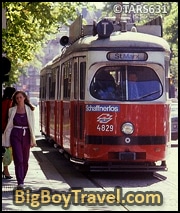
While the Tram #1 and #2 lines overlap for part of the Ringstrasse you will have to switch lines halfway through to complete the full loop. Each line goes a couple of miles out of the way where they split from the loop so you have to pay attention when it’s time to switch lines. In the East, Tram #1 splits off with access to the Hundertwasserhaus and Prater Amusement Park while Tram #2 splits off to the North to Augarten Park with its famous Flak Towers.
Another helpful set of Red Trams are #71 and #D ( purple on our map ) which run up the Western and Southern side of Vienna’s Ring Road along the same tracks as #1 & #2. This stretch is where most of the sights are making these two trams a good addition to your tram tour mix. As they exit the Ring Road in the East, Tram #71 runs along the Northside of Belvedere Palace all the way to both Mozart’s and Beethoven’s Graves ( see our map ). Tram #D splits to run along the Southside of Belvedere Palace for easy access to see the grounds and goes all the way to Vienna’s Main Train Station.
Red Tram Hours : 4am-Midnight, every 5-10 minutes. Tickets : Single ride tickets are 2.20€ and you’ll have to use one every time you get on. Unlimited City-wide Tram/Bus/Metro Pass is 7.60€ for 24 Hours, 13.30€ for 48 Hours, & 16.50€ for 72 hours.
2. Yellow Tourist Tram :
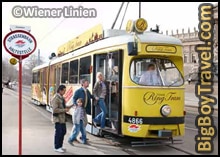
Please note that the Yellow Tourist Tram no longer lets you get out at any of the attractions during your loop. Although it doesn’t have a hop on hop off tram tour option, this line is enjoyable if you want to take in all the sights quickly. This 31 seat tram is complete with LCD screens going over the highlights and has headphones for narration in 8 languages .
Yellow Tram Hours : Daily 10am-6pm; last Yellow Tram leaves the Schwedenplatz Tram Stop at 5:30pm. Yellow Tram Tickets : A special ticket is needed to ride this tram for a one-time 25-minute continuous loop ride which costs 10€ ( 5€ for children ). More Info : Yellow Tram Website .
3. Underground Subway :
About The Subway : While the road level tram lines are the best way to experience the Ringstrasse, you can also hit up most of the sights by using Vienna’s extensive underground Subway lines ( marked on our map as thin lines ). Printable Subway Map : Click Here .
Vienna Ringstrasse Tram Tour:
1. museum quartier :.
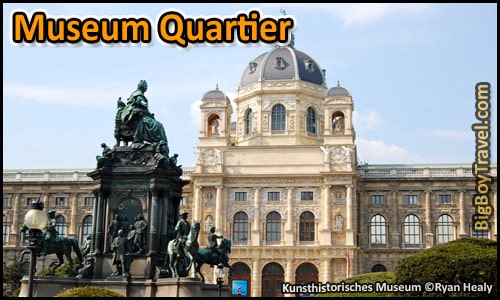
About The Museum Quartier : We love to start our Vienna Ring Tram Tour on foot exploring the Museum Quartier which has the best collection of museums in town. Framing the vast Maria Theresa Square are two huge twin museum buildings which were originally planned to be part of an even larger called the Emperor’s Forum ( Kaiserforum ) . The Kaiserforum was meant to serve as an Imperial Forum celebrating the might of Austria. The forum complex, like the construction of the Ringstraße over Vienna’s Medieval wall, was one of Emperor Franz Joseph I’s ambitious civil projects in the mid-18000s that helped to rapidly grow the city.
As seen in this 1865 mockup sketch , the Emperor’s Kaiserforum complex was planned out to be massive with tons of building when construction started in 1872. Unfortunately, there were maybe too many projects going on at once as after 19 years of elaborate construction the project was scaled back to its present yet still impressive form. Before exploring the museums, don’t overlook the imposing statue of Maria Theresa ( the namesake of the central square ) who was the only female ruler in the Hapsburg Dynasty ( 1740-80 ), revitalized the fluttering empire, and influenced much of Europe.
Visiting the Southside of the square you’ll come to the Art History Museum ( Kunsthistorisches, website ) which holds Vienna’s greatest collection of paintings covering very fun loving art from over a 200-year span. The most famous painting is the 1563 masterpiece by Bruegel depicting the Tower of Babel in Babylon ( modern day Iraq ). We love the view from the third floor of the round central hall in the museum which is one of the most beautiful rooms in Vienna. Locally this wonderful art gallery, which also has an excellent Egyptian collection, is known simply as the Kunst.
Opposite the Kunst, in the nearly identical building on the North side of the square is the Museum of Natural History ( Naturhistorisches, website ). This museum holds Austria’s most famous work of art, the Venus of Willendorf , in its vast collection. The only 4-inch-tall Venus statue is a chubby, naked female figure carved into limestone and is dated to be from between 24,000-22,000 BC. The Natural History Museum also has a very famous collection of slides from the 1700s of microscopic organisms called the Mikrotheater.
On the relative outskirts of the two main museum buildings ( to the West ) is a third collection worth a stop for any modern art lover, the Leopold Modern Art Museum ( website ). Our favorite piece at the Modern Art Museum comes right away and is an upside down house home smashed into the side of the Museum called House Attack. Interesting, this very modern art museum is housed inside the old Imperial Horse Stables.
Art History Museum Hours : Tuesday-Sunday 10am-6pm, open on Thursday until 9pm, closed Mondays. Art History Cost : 14€ for Adults, Children and teens are free, but a guided tour is 3€ extra. Combo ticket to include Neue Berg is 20€ for both or for the Leopold is 22€ for both. Natural History Museum Hours : Wednesday-Monday 9am-6:30pm, open on Wednesday until 9pm, closed Tuesdays. Natural History Museum Cost : 10€ for Adults, Children and teens are free, but a guided tour is 3€ extra. The best deal also includes the nearby Neue Berg for just 20€ for both. Leopold Museum Hours : Tuesday-Sunday 10am-6pm, open on Thursday until 9pm, closed Mondays. Leopold Museum Cost : 12€ for Adults, students 8€. Combo ticket to include Kunsthistorisches is 22€ for both.
2. Hero’s Square ( Heldenplatz ):
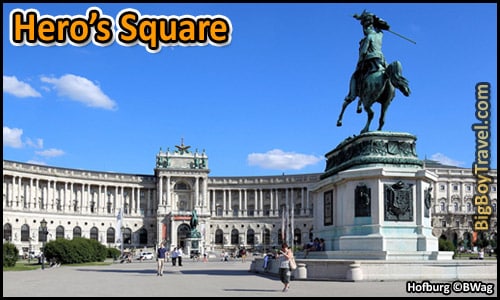
About Hero’s Square : As you cross into Hero’s Square, you’ll immediately run into a massive gateway over the road called Auberes Burgtor . The columned gateway is all that remains from a wall built around the Palace in 1817 after the original castle wall was damaged during the Napoleonic Wars of 1809.
While the wall was repaired after the Napoleonic Wars, the didn’t last long as the entire Medieval around Old Town Vienna was torn down in 1860 by Emperor Franz Joseph I to make way for the Ringstrasse loop. This move helped the growing city expand and was part of an extensive series of enhancements the Emperor made to the City.
As you pass through the gateway, it opens up into the large Heldenplatz ( or Hero’s Square ) complete with a backdrop of beautiful Neue Burg ( or New Castle ). It can be easy to get distracted by the fantastic curved building, but the square itself is worth investigating. Heldenplatz and two other large gardens ( Burggarten & Volksgarten ) were laid out after parts of a Medieval castle wall that stood here were destroyed Napoleonic Wars.
While the other Gardens have remained green, most of Heldenplatz has been paved over during the decades, but a couple of the original equestrian statues remain. Our favorite statue is Prince Eugene of Savoy and sits right by Neue Burg’s main entrance. Eugene left France for Austria after being denied admission to their military for appearance and went on to become the greatest Generals in Austrian history. He led military campaigns for 60 years over 3 different Holy Roman Emperors based out of Vienna and was very successful. The gain fame with battles over the Ottomans was later gaining massive praise from Napoleon all while getting super rich from his endeavors.
To this day Eugene serves as a point of Austrian pride and willpower. On your walk over to Volksgarden in 2 stops, you’ll also pass a great statue of Archduke Charles of Austria riding a horse while triumphantly holding a flag. The statue of Charles, erected in 1860, was meant to portray the Habsburg Dynasty as great Austrian military leaders.
3. New Royal Palace ( Neue Burg ):
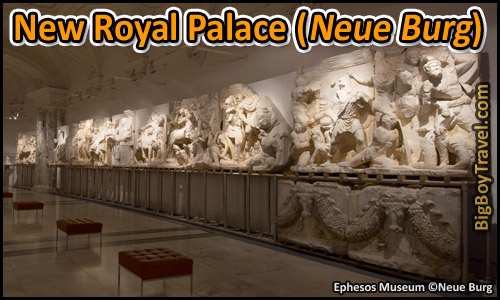
About Neue Burg : While you’ve already visited the first parts of Emperor Franz Joseph’s Kaiserforum at the Museum Quartier, the Neue Burg Wing ( or New Castle ) wing of Hofburg Place was probably the biggest part of the new complex. This huge palace section was started in 1881, but its construction was drug out for over 30 years into the beginning of WW1 which Austria lost, further delaying the project. Because of the enormous delays, most of the rest of the Kaiserforum complex was scrapped , but the completed buildings are really impressive.
Once inside Neue Burg, it is easy to be in awe of the marble-lined corridors, grand staircases, and our favorite is called the Hunting Plateau which is a common place for weddings. The incredible details of the grand Neue Berg make it the perfect setting for the building many museum collections. The 1st collection that was housed here came from Archduke Franz Ferdinand in 1908 after he got back from an extensive trip around the World. After the Franz Ferdinand was assassinated in 1914, which sparked WW1, his entire collection was given to Neue Berg giving a starting to a series of wonderful museums.
Today the building houses Collection of Ancient Musical Instruments, Collection of Arms and Armor , Papyrus Museum, and Ephesus Museum . Our favorite of these museums is the Ephesos which has a great collection of classical and even ancient statues. The highlight of the Ephesus Museum is the Parthian Monument, part of an antique altar erected at Ephesus ( modern-day Turkey ) during the Hellenistic Period.
While the Neue Burg section of the Hofburg Palace is run by the Kunsthistorisches Museum the main part of the Palace sits just to the North and also worth a visit. Because of the location of the entrance the main Hofburg Palace is best seen in our Old Town Walking Tour . Highlights of visiting this historic landmark include the Imperial Apartments, Sisi Museum, and the Imperial Silver Collection. We suggest getting the Sisi ticket as you will also be able to see the Imperial Furniture collection and a free pass to tour Schönbrunn Palace.
Neue Burg Museum Hours : Wednesday-Sunday 10am-6pm; Closed Monday & Tuesdays. If you only have time for one museum stop, consider the world-class collection of museums at nearby Museum Quartier instead of Neue Berg. Museum Cost : 15€ for Adults; Children are free; and guided tours are 3€ extra. Your ticket covers all of Neue Burg’s Museum plus the Art History Museum ( Kunsthistorisches ) in Museum Quartier. You can also get a combo ticket to include the Natural History Museum and Leopold Modern Art Museum for a couple euros more. We’ve bought the combo ticket and they let us see the two museums on different days, but ask to make sure. Neue Burg Website : Here .
4. The People’s Garden ( Volksgarten ):
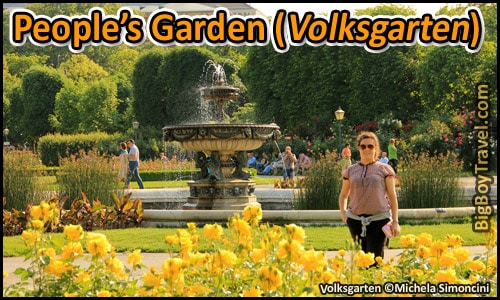
About Volksgarten : The People’s Garden Park was one of the first public parks in Vienna and led to the Royal family significantly expanding public spaces. The park has an excellent free Rose Garden which is a real treat to visit during the Summer months.
If you are looking for the most peaceful spot in Vienna’s city center, look no further than Volksgarten’s white-washed Empress Elizabeth statue and alter . The Empress, known as Sissi, was the wife of Emperor Franz Joseph I in the late 1800s. Sisi was widely known for her beauty and was endeared by citizens.
Probably the most prominent sign of ancient influence on early Vienna is Volksgarten’s modern replica of the Greek Temple of Hephaestus ( Theseion, Greek patron of the craftsmen ) . The original temple in Athens, Greece opened in 433BC while the Celts had a small camp in Vienna along the Danube. Later, the Romans started fortifying Vienna in 97AD and parts of their ancient Vindobona Fort can still be seen around Old Town today.
5. Austrian Parliament :
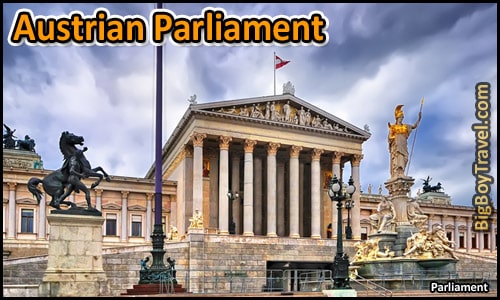
About The Austrian Parliament : Gleaming over the Ringstrasse like a mighty Roman Temple, the Austrian Parliament is truly a powerful looking government building. In front of the beautiful building is a substantial white fountain capped off with a statue of Athena , the Greek goddess of wisdom, wearing golden armor is the main attraction. This fountain is a real statement piece and leads to some of the coolest photos in Vienna. If you choose to join one of the free guided tours of the interior, you’ll tour both chambers of the building, the National Council ( Nationalrat ) and the Federal Council ( Bundesrat ) .
Free Guided Tours : 55 minute guided tours are available at the top of the hour Monday-Saturday at 11am-4pm. In the offseason, they only have the Noon and 1pm tour on Saturdays. Parliament Website : Here .
6. City Hall & Beer Garden ( Rathaus ):
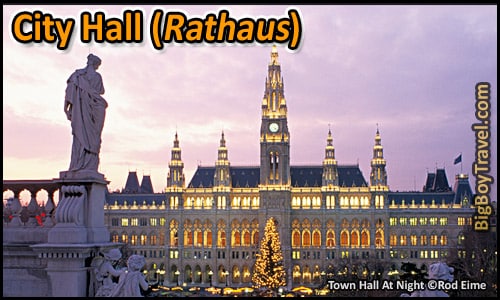
About Vienna’s Town Hall : The City Hall is an enjoyable place to take a break during the tram tour. As you step off the tram, you’re confronted with the enormous Neo-Gothic towers of City Hall which overlook a vast square, called Rathaus Platz. This square is famous for hosting Vienna’s main Christmas market and ice skating rink in the Winter and often turns into a huge beer garden throughout the Summer months ( July & August ). There are even outdoor movies and concerts that happen here most weeks of the Summer and Fall. The setting with the amazing backdrop of the City Hall over the square is stunning.
The largest of the towers on Vienna’s Town Hall is over 321 feet tall and is capped by a 17-foot-tall Rathausmann who stands guard over Vienna. The watchman might not look that big from the ground, but he weighs over 1400 pounds and is so large that he takes a size 31 shoe! When the City Hall was completed in 1883, the Emperor made sure that the tower was 3 feet smaller than the 324-foot-tall tower of neighboring Votive Church . Technically though, City Hall is 342 feet tall with the Rathausmann and flagpole added to the top. You are free to hike the 331 steps to the top of the tower for some great views although it is closed in 2019 for restorations.
There are ongoing tours three times a week to see the interior of Vienna’s Town Hall, but they are a bit boring in our opinion. Luckily though you can see the famous Marble Staircase any time of the business hours Monday-Friday. To reach the gorgeous staircase you can enter the Southern door and it will be on your right ( look for the sign Feststiege 1 ) or you can enter from the Information Office on the Westside and work your way through the courtyards. Make sure to walk up the steps to the top to get the most famous view of the multi-level white marble staircase covered in bright red carpeting. This space on one of the highlights of our do-it-yourself free Vienna Ring Tram Tour.
Free Guided Tours : If you want to get a closer, in-depth, look at City Hall’s Senate Chamber, Coat of Arms Room, Festival Hall and more they have free tours. The City offers free guided tours in German at 1pm on Monday, Wednesday, & Friday. To join a tour group, check their tours website ahead of time. If you don’t speak German, don’t worry, they have a ton of multilingual audio guides available for checkout. Town Hall Website : Here .
7. National Royal Theater ( Burgtheater ):
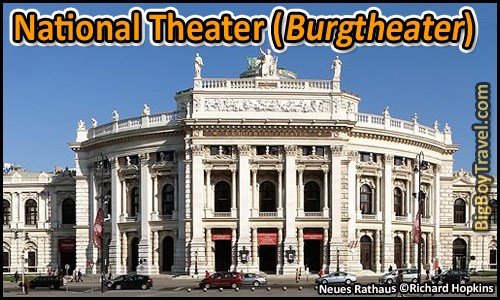
About Burgtheater : Sitting directly across from Vienna’s Town Hall, it is impossible to miss the beautiful facade of the renowned National Royal Theater ( Burgtheater ) as you take our Ring Tram tour. The first Royal Theater was opened in 1741 in an unused banquet hall of Hofburg Palace along Saint Michael’s Square with Empress Maria Theresa’s permission. It was only one generation later, in 1776, that the successful theater became the official Royal Theater ( Burgtheater ) under the watch of Emperor Joseph II. Many famous premieres took place at the theater including Mozart’s Marriage of Figaro in 1786 and Beethoven’s 1st Symphony in 1800.
After 14 years of construction, the new Royal Theater building opened in 1888 at its current location and was one of the final projects to help round out the new Ringstrasse ( Ring Road ). While the building was damaged during WW2, the theater was rebuilt in the 1950s. Through the centuries the Burgtheater has been considered the best theater in the German-speaking world and has a permanent ensemble of more than 80 actors and actresses. If you are looking to catch a great show, the theater still houses some of the best playwrights and performances in Austria even though new theaters have been built.
Right next to the National Theater is the most popular cafes on the Ringstrasse called Cafe Landtman ( website ). The Cafe, opened in 1873, has been visited by Sigmund Freud, the Dutch Queen Juliane, Hillary Clinton, and Paul McCartney.
Guided Tours : Daily tours at 3pm last 1 hour and are in German Monday-Thursday and English Friday-Sunday. In July and August, each tour session is in both languages. Show Tickets : Show tickets can be bought online Here and range from $2.50 for standing room tickets up to about $51 for prime seats. Theater Website : Here .
8. Beethoven’s Pasqualati House :
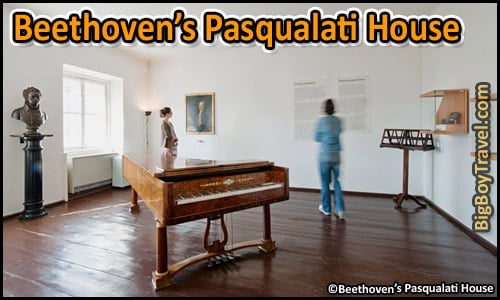
About Beethoven’s Pasqualati House : The Pasqualati House is where Beethoven lived and composed for 11 years from 1804 to 1815. While it is a huge house, Beethoven only rented out two large rooms on the 4th floor which was still luxury for his time.
Today Beethoven’s former residence is preserved as a museum complete with many of his original possessions. When he lived her,e Beethoven’s rooms had excellent views on what was then the Vienna Woods . Beethoven composed a few of his most important works in the apartment including the Fourth, Fifth and Seventh Symphonies, Fourth Piano Concerto, Violin Concerto, and his only opera Fidelio.
By the time Beethoven moved out of the Pasqualati House in 1815, he had become quite famous and almost completely deaf. After Beethoven died in 1827, the dark green door from the house he died in was moved to the Pasqualati House and is still used as the entrance.
If you are a huge Beethoven fan, you should consider visiting his grave site in the nearby Zentralfriedhof Cemetery which is stop #2 on our Additional Attractions Page . There is also a statue of Beethoven toward the end of this free Vienna Rine Tram Tour on Beethovenplatz. If you are not interested in touring the inside of Beethoven’s home, from outside of the building, the windows his rooms can easily be seen straight above a large chunk of the old city wall on the 4th floor.
Museum Hours : Tuesday-Sunday 10am-6pm with an hour break from 1-2pm; Closed Mondays. Cost : Adults 4€, People under 19 are Free. Museum Website : Here .
9. Votive Church ( Votivkirche ):
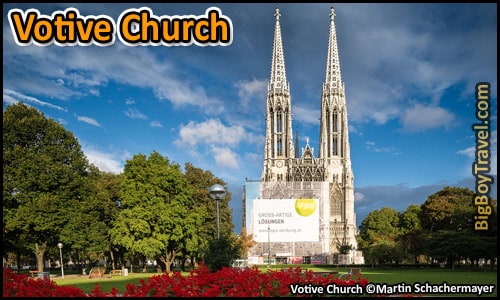
About Votive Church : Completed 4 years before Vienna’s City Hall in 1879, the massive Votive Church ( vol-teaf ) was built on the site of a failed 1853 assassination attempt of Emperor Franz Joesph by a Hungarian nationalist. The church was commissioned by Franz’s brother Ferdinand Maximilian Joseph, who later become emperor of Mexico, as a way of giving praise to God ( votive offering ) for sparing Emperor Franz Joesph’s life. There was also a sub-message in the grand building to remind other possible revolutionaries of the Habsburg’s divine power.
As an added bit of religious symbolism, the floor plan of the Church itself is laid out in the shape of a cross. Votive’s two overpowering towers are awesome places to take pictures and even though it can be hard to fit all into one frame. Church Website : Here .
10. Sigmund Freud’s Home :
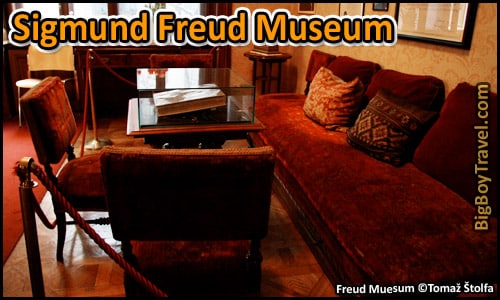
About Sigmund Freud’s Home : Welcome to the home and office of Sigmund Freud, one of the most influential thinkers of the 20th Century who is credited as the father of Psychoanalysis . He was very innovative and believed that both libido and unconscious drives could explain a lot about a person’s mental state as well as actions. By digging into patients repressed emotions and memories, Freud was able to reveal their unconscious thoughts and motivations to help them control their impulses. When visiting Freud’s home and office you get to sit in the same waiting room his patients would wait in to meet with the Doctor.
Hours : Daily 9am-6pm. Cost : 10€ Adults; 7.50€ Students. Guide Tours : While an audio guide is included for free, there are also guided tours for 3€ at 11am & 2pm daily. Museum Website : Here .
11. Rossauer Military Barracks :
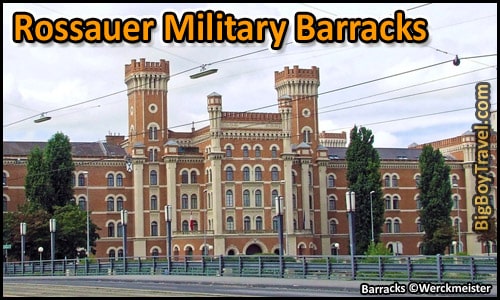
About Rossauer Military Barracks : The castle-like, red brick Rossauer Military Barracks ( Roßauer Kaserne ) is one of 3 barracks Emperor Franz Joseph had built in Vienna during the late 1800s. This one housed 4000 troops and almost 400 horses, but wasn’t built to defend against outside forces ; instead it was created to protect against the Austrian public’s growing desire for Democracy. The 1848 Revolution was viewed as a significant threat to the Empire and the new Barracks was a good tool to remind the Public of the Emperor’s might. The Barracks is not open to the public, but the contrast of the building’s red-brick exterior to its surroundings is a favorite among photographers.
Located just inside the Ringstrasse, the Vienna Stock Exchange Building ( or Borse ) looks like a smaller version of the Barracks. The Stock Exchange, often called the Temple of Money, even seems to be made out of the same red bricks as the Barracks. It was near the Stock Exchange that the Roman training colosseum was built just outside the walls of the fort Vindobona as early as 97AD.
12. Anti-Gestapo Memorial Site :
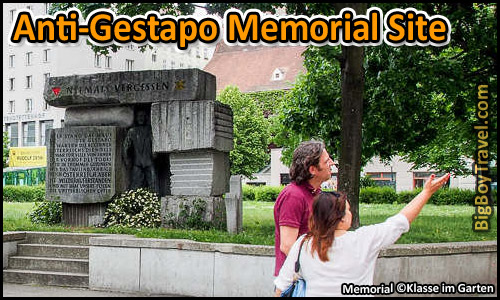
About The Memorial Site : The Vienna headquarters of the Nazi’s evil Secret Police group, the Gestapo , was located at this very spot in the Hotel Metropol which was destroyed in WW2. The Gestapo relied on terror to get what they wanted as prisoners were often tortured for weeks to obtain false confessions, and were even sometimes even sent to prison camps or killed. Today a memorial sits over the spot of the former headquarters to remind us of the suffering and murder of countless people.
Near the main Memorial, there is a large relief on the facade the building across Salztorgasse which depicts the agony that thousands of prisoners had to endure. Footprints that lead into the building through what was the back entrance of the Gestapo headquarters and symbolically don’t return out the other side.
13. Saint Ruprecht’s Church ( Ruprechtskirche ):
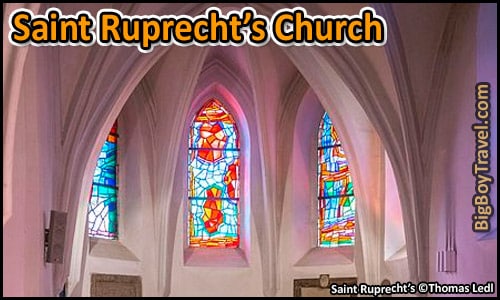
About Saint Ruprecht’s Church : Saint Ruprecht’s Church is considered by many to be the oldest church in Vienna . The church was first founded in 740 by 2 Monks from Salzburg and the current building was built sometime between 900-1100. The name comes from Bishop Ruprecht who founded Salzburg’s Saint Peter’s Abbey in 696 and later became the Patron Saint of the Salt miners after his death on Easter Sunday in 710. At the time the church was built it sat inside the original wall of the Roman camp Vindobona before it was expanded outward as modern Vienna through Medieval times.
Along the outside of the nave and lower part of the tower are remains from the only section of this part of Vienna’s city wall to make it through the Fire Of 1276 which burned a lot of Old Town. The Church’s Romanesque, almost Gothic, the tower looks stunning in the summer and fall while covered with lush leafy vines . The trunks of the vines spider all the way up the wall of the Church and give photographers a treat as they beautifully frame statue of Saint Ruprecht.
Inside Saint Ruprecht’s Church, the central stained glass windows also survived the great fire and date back to 12070. If you search around the small chapel, you find the skeletal remains of martyr Saint Vitalis elegantly dressed in a glass coffin which Empress Maria Theresa gave to the Church as a gift in 1765. Church Website : Here .
Stopping at Saint Ruprecht gives you the best opportunity to explore the Medieval streets of the Roman Camp Vindobona which pre-date Vienna. Some remains of the Roman camp can still be seen across the canal in the form of small run-down rock walls. One Block Southwest of the Church was once the Pine Market ( Keinmartkt ) which was a popular market from 1247. Straight South of the Saint Ruprecht’s is the City Jewish Temple which is one of the only ones in Vienna to make it through WW2. Just beyond that is Hoher Market which dates back to the 1300 and holds Vienna’s worthwhile Roman Museum.
A personal favorite of ours is the Griechenbeisl Restaurant and Inn open since 1447 with wine cellars date back to the 1300s. It’s said that bagpiper Marx Augustin wrote his hit song Lieber Augustin here in 1679. A beautiful marker for Augustin with a lush vine backdrop is one of Vienna’s best photo opportunities. If you were thinking about visiting either the Mexican Church, Donautrum Tower, or Prater Park ( all listed in our additional attractions section ) this is a great spot to jump on the metro and do so.
14. Vindobona & High Market ( Hoher Markt ):
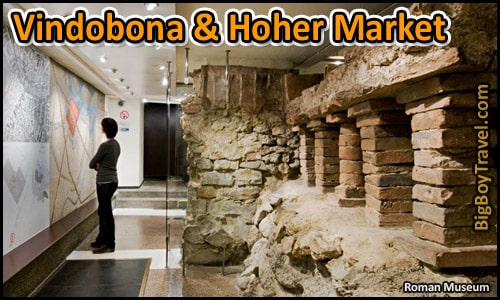
About Vindobona : As you walk from Saint Ruprecht’s Church to Hoher Market you will be headed toward what was once the heart of the fortified Roman camp called Vindobona ( meaning White Village ) which predates the founding of modern Vienna. The fort was built in 97AD and housed 6,000 Roman legion soldiers with another 24,000 civilians living outside of the walls.
While Vindobona was much smaller than the 50,000-person regional Roman capital of Carnuntum just 30 miles to the East, it helped to define the Northern edge of the Roman Empire. After the Northern part of the Empire collapsed in 433AD, the remaining citizens around Vindobona moved inside the walls of the abandoned camp which then hit a steady decline.
The former camp was re-fortified including a small castle Berghof Restsiedlung built in 800AD over former Roman baths next to today’s Hoyer Market to help defend against Magyar ( Hungarian ) armies. Shortly after, in 881, Vindobona took the name Vienna ( Wein ) after the Vienna River ( Weinfluss ) which is Celtic for Wood Creek .
In 1156, Heinrich II of Babenberg was forced by the Holy Roman Emperor to give up his title Duke of Bavaria to Henry the Lion and was named the 1st Duke of Austria by the in return. With a fresh canvass at his disposal, Heinrich II moved to Vienna and built Castle Babenbergerpfalz inside the Southwest corner of the old Roman wall on the foundations of Vindobona’s former barracks. This established the 1st official Royal Court and elements of Vindobona’s Roman past started to become harder to find.
In 1246, Ottokar Duke of Moravia ( King of Bohemia ) moved the royal castle out of Vindobona and started to expand the city wall in all directions to follow the path of the Ringstrasse. More changes happened when the next Duke, Rudolf I of Hapsburg ( King of Germany ), was elected starting what would be a 500-year family dynasty.
Hoher Market also saw changes under Hapsburg rule as it revamped into a lively market square in the 1300s complete with a beautiful fountain. By the 1700s the square surrounded by grand mansions and the fountain was done in bronze and marble with a wedding theme. It was business as usual for the square until 1949 when post WW2 sewer line excavations revealed ancient Roman barrack foundations from the days of Vindobona below Hoher Market. The findings were unexpected as the foundations had complete sections of walls from Roman military officer villas and geothermal heaters from nearby baths. The excavations were opened to the public shortly after and were later combined with additional artifacts from Michael’s Square found in 1990.
Today the ruins are part of Hoher Market’s Roman Museum highlighting the history of early day Vindobona. We highly suggest a visit along with a bite to eat at the square’s famous Wurstel Vienna Sausage Stand. If you are lucky, you will also be able to catch a show at the Anker Musical Clock while at Hoher Market. Built from 1911-1914 the Art Nouveau clock has a “parade” show daily at Noon and Xmas songs during Advent at 5 & 6pm.
Roman Museum Hours : Tuesday-Sunday 9am-6pm; Closed Mondays. Roman Museum Cost : Adults 7€ ; kids free. Wurstelstand Hours : 9am-4am.

15. Hermann Park Beach :
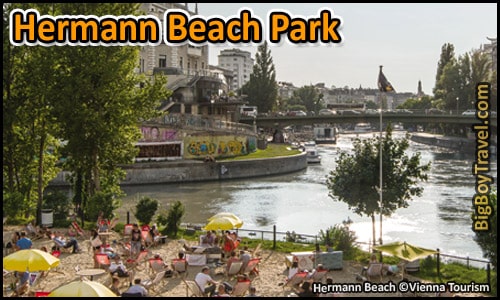
About Hermann Park Beach : Maybe the best hidden gem on the Ringstrasse is the huge Hermann Park Beach on the shore of the Danube River. There are a couple other man-made beaches on the Danbue, like the nearby Danube City Beach ( website ), but the Strandbar ( website ) at Herman Park makes it the best choice. The bar sits right in the middle of the large beach and has tons of umbrella chair seating to help make the experience like no other.
We also love the backdrop of beautiful buildings like the domed Urania Theater built as an observatory by Emperor Franz Joseph in 1910. Hermann Beach was also the location of Castrum a small Celtic settlement at the mouth of the Vienna River going back to 500BC which greatly pre-dates the Roman Camp of Vindobona ( 97-433AD ).
Hermann Beach Bar Hours : Daily 10am-2am. Danube City Beach Bar Hours : Daily 1pm-11pm.
16. Viennese City Park ( Stadtpark ):
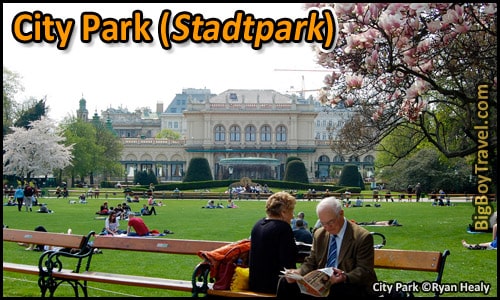
About Viennese City Park : The Viennese Park honors the music that makes the Viennese Balls possible with a ton of statues of the famous local composers and musicians. The gold colored concert hall on the south end of the park is called the Kursalon and was opened in 1867 by the Strauss brothers who essentially created the Waltz.
A statue of one of the brothers, Johann Strauss, depicts him covered in gold while playing his violin. Johann was famous for playing his violin while conducting and the beautiful statue is one of the most highly photographed spots in Vienna. If nothing else, the Viennese Park serves as a great place to relax and people watch for a while. On the far Northwest corner of the park, a statue honors former Mayor Dr. Karl Lueger, who pushed the Emperor to modernize Vienna in the mid-1800s.
17. Schwarzenberg Square :
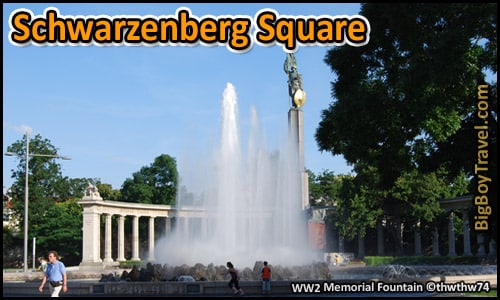
About Schwarzenberg Square : Schwarzenberg Square ( Schwarzenbergplatz ) is best known for having a couple of interesting statues. The first statue is a green equestrian one of Prince Charles Schwarzenberg who fought against Napoleon, typically this statue is covered in pigeons and bird poop. The second statute, at the end of the square, is a columned fountain in honor of the Soviets who died freeing Austria from the Nazis in WW2.
Don’t feel discouraged if you are underwhelmed by this stop as it is the best place to hop off the Ringstrasse Tram Tour to visit either nearby Belvedere Palace or our next stop Saint Charles Church. Check out our additional attractions section for details on Belvedere Palace which is connected to Schwarzenberg Square by Tram Line D.
18. Saint Charles Church ( Karlskirche ):
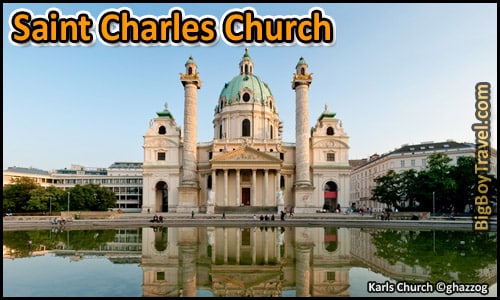
About Karlskirche : The giant white Saint Charles Church dates back to the early-1700s and is a favorite of photographers with its large green dome and huge reflecting pool . The Church was commissioned by the Emperor after Vienna’s last bout of Plague as he felt that his prayers were the reason why the Plague stopped. That train of thought is a common theme throughout Vienna’s history as after each tragedy the ruling Emperor would use it as a reason to build an even bigger and more extravagant Church.
Cost : 4€. Hours : Daily 9am-7pm. Website : HERE .
19. Naschmarkt :
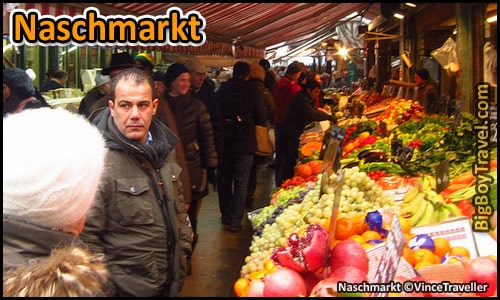
About Naschmarkt : The 6 block long Naschmarkt is Vienna’s most popular produce market . An active market has been operating here since 1780 and today has 100 vintage stalls. Near the start of the Naschmarkt is the Session Art Museum , windowless space known as the Cabbage Head. The building has a large golden dome made in a modernist style by the Secessionists. Design of the building is meant to be a white canvass for exhibits instead of a classic museum.
Cost : Free. Hours : Stalls open Monday-Friday 6am-7:30pm; Saturday 6am-6pm; food & drink Monday-Saturday until 11pm. Website : HERE .
20. State Opera House ( Staatsoper ):
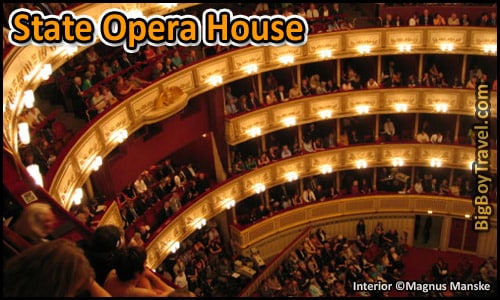
About The Opera House : In a city known for music, the 1,200 person State Opera House takes the cake. The hall has housed some of Austria’s best musicians over the years and still has 70 different works with over 300 performance a year. The Opera House is also a great place to start our City Center Walking Tour . which is a great compliment to this Vienna Ring Tram Tour.
Opera House Tours : 6.50€ also includes the Opera Museum, 1-4 tours daily, times vary by day but is updated monthly on their website, the tour is great and brings you to a lot of backstage areas. Performances : If you are not that into three hours of opera, they also sell 567 standing room only tickets per show, 160 of which can be right below the Emperors’ box. Standing room tickets are cheap, 2€ upstairs and 3.50€ downstairs, and allow you to easily leave when you’ve had your fill. Standing room only tickets go on sale 60 minutes before each show at the front door and 80 minutes before the show inside the side door at the Stehplatze booth. Website : HERE .
21. Castle Park ( Burggarten ):
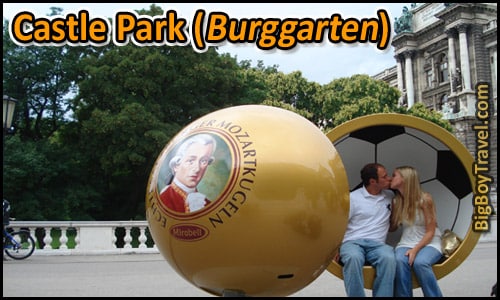
About Castle Park : Burggarten, or Castle Park, was revamped in the early 1800s and has been a favorite of visitors ever since. The park has some an awesome backdrop thanks to the enormous Neue Burg Wing of Hofburg Palace. Through the large green space are elegant statues and even a relaxing pond. Our favorite place to reflect on the day is in the Northwest corner of Burggarten where there is a small open area with an excellent white-wash Mozart statue .
As part of the front end of a large makeover to the Hofburg Palace, the Emperor had a gigantic greenhouse over 22,000 square feet built, dubbed the Palmen House . The greenhouse was a huge luxury and housed a ton of tropical plants and palm trees. The greenhouse has since been turned into of our favorite restaurants in Vienna where you can eat under the palms no matter how cold it is outside. Consider stopping at the tropical Butterfly House which is attached to the North side of the restaurant.
Other Sights Near The Ringstrasse:
22. vienna city center walking tour :.
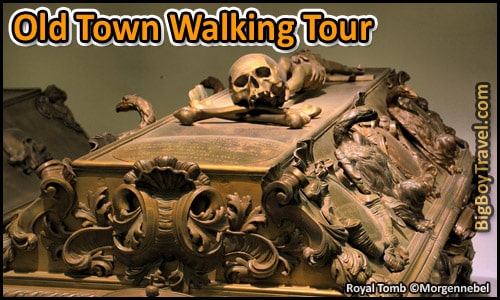
About Our Old Town Walk : If you are looking to further explore the rest of the amazing sights in Old Town Vienna then the area around Burggarten is the perfect place to pick up our Free Old Town Vienna Walking Tour which starts from the Opera House. The tour covers the real heart of Vienna from the Medieval shopping streets, Imperial crypts, the might Saint Stephen’s Cathedral, and even the modern sights.
Read More : Free Old Town Vienna Walking Tour .
23. Upper Belvedere Palace :
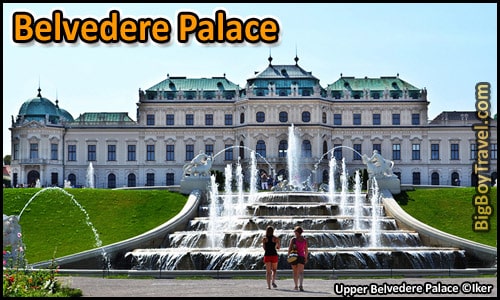
About Belvedere Palace : Completed in 1723, the Upper Belvedere Palace was built by Prince Eugene after he successfully held off attacks on Vienna by Ottoman forces. The full grounds of Belvedere, meaning beautiful views in German, are quite expansive with the beautiful Upper Palace ( Eugene’s party house ) and the Lower Palace ( his garden villa ) separated by a vast garden.
The use of green space is fitting as part of the palace grounds were once used as a botanical garden in Roman times. Both the exterior and interior of the Upper Belvedere are impressive although they pale in compassion to the amazing Schonbrunn Palace in Vienna which is among the top 2 in all of Europe. We suggest visiting the Upper Palace if you have time and skip the Lower section. Hours : Daily 10am-6pm.
Read More : Belvedere Palace Tours .
24. Schönbrunn Palace :
About Schönbrunn Palace : This sprawling 1,441-room yellow palace is among the top five royal estates to tour in all of central Europe. It sprung up in the 1700s from the Hapsburgs Royal Hunting lodge, which at the time are considered far into the country from the city walls of Vienna. While Schönbrunn Palace is home to the world’s oldest zoo, we love the property for its magnificent gardens and lavish interior. Most of the biggest changes to the estate were made in the 1800s by Emperor Franz Joseph I and his wife Elizabeth, known as Sisi. Stories of this famous royal couple are a true highlight of any guided tour of their wonderful summer palace.
Read More : Schönbrunn Palace Tours .
Featured Article

Sign Up For Our Newsletter For Free Travel Tips
Email Address *
Disclaimer: Information on this page and in our walking tours were deemed accurate when published, however, details such as opening hours, rates, transportation, visa requirements, and safety can change without notice. Please check with any destinations directly before traveling.
Walking guide to Vienna's famed Ringstrasse
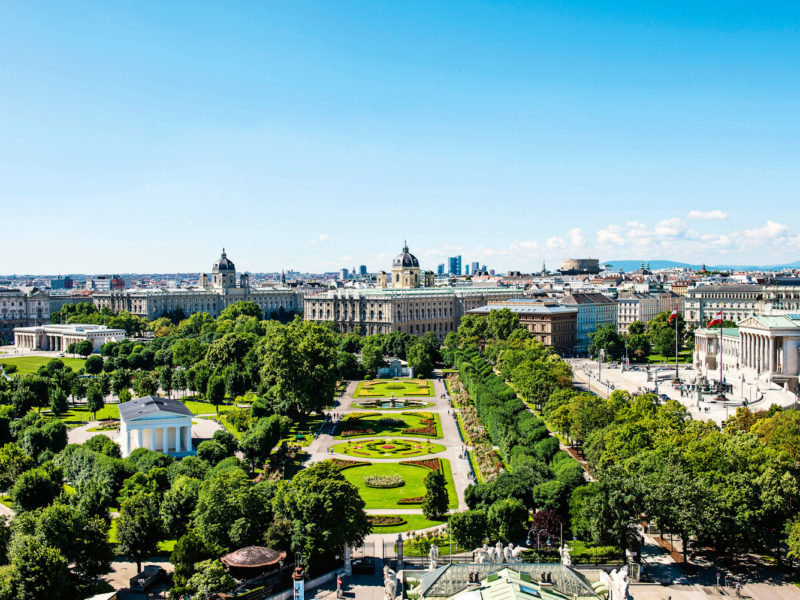
The iconic Ringstrasse in Vienna, Austria. Photo by Christian Stemper.
Last updated . 18 February 2020
One of Europe’s most masterful boulevards, Vienna’s famed Ringstrasse celebrates a distinguished milestone this year. Here, Quentin Long strolls past some of its most imposing structures and through 150 years of compelling history.
If there is one ring to rule them all, then in Europe it must be Vienna’s Ringstrasse.
While many will argue that the grandeur of the Champs-Élysées can not be rivalled anywhere in the world, its hordes of tourists and crass retail make the Paris centerpiece an underwhelming experience.
By contrast, the Ringstrasse has altogether more charm. A sophisticated marvel of modern civic planning, design and architecture, the Ringstrasse is unmatched in beauty and drama.
As it celebrates its 150th year, we take you on a journey past some of the majestic thoroughfare’s most interesting buildings, revealing the true extent and magnificence of Vienna’s golden age.
A social revolution
Like most mega European cities, by the mid-19th century Vienna had outgrown its medieval walls.
The population of the Habsburg’s mightiest city was booming but there was much consternation between the elite and the bourgeoisie.
The swelling middle classes were demanding equal status, influence and rights to land which, up until that point, had been reserved for the aristocratic elite.
The walls and the glacis, a cleared parkland deemed necessary for the protection of the city, ensured there was plenty of space between those that ruled and those that were ruled.
In 1857, Franz Joseph I settled the matter by declaring “Es ist mein wille” (It is my will) for the walls to be razed and the boulevard to end all boulevards to be built to show off the might and glory of the Habsburg Empire.
And so began what Viennese and Austrians refer to as the Ringstrasse Era (much like what the British would refer to as the Victorian or Edwardian eras), characterised not just by 50 years of continuous construction in Vienna but, most importantly, the ascendancy of merchants and the bourgeoisie, particularly the Jewish middle class, to their rightful place of influence amongst royalty and the aristocracy.
After all, it was the middle classes’ purchase of prime land to build palaces to show off their own wealth and power on the Ringstrasse that funded the construction of the public buildings and roads.
So whilst the Ringstrasse was a phenomenal example of modern town planning, resulting in an impressive, grand city promenade, it was also an important catalyst for enormous cultural change.
Historicism architecture and the Ringstrasse
The buildings of the Ringstrasse are an incongruous cacophony of architecture to the uninitiated, lurching from Classical to Gothic to Renaissance to Baroque in the space of a few blocks.
But all of these styles form part of the Historicism movement, where the practical purpose of the building was reflected in its architectural style.
To illustrate the point, take the Parliament building, which is built in the Greek Revival style as Greece is the birthplace of democracy; City Hall is neo-Gothic because of civic autonomy originating in Flanders; the State Opera is neo-Renaissance in design because of the Italian Renaissance’s role as the propagator of science and art across continental Europe.
1. Imperial Forum
(hofburg palace/neue burg, kunsthistorisches and naturhistorisches museums).
Style: Neo-Baroque
These three structures – the never completed Imperial Forum, now known as the Neue Burg, the Museum of Fine Art and The Natural History Museum – should be appreciated as one entity.
Designed to rival the Louvre, a fourth structure was meant to be an identical facing wing to the Neue Burg joined by arches but as it had no purpose other than an ostentatious display of power it was replaced by Heroes Square (Heldenplatz).
The buildings are dramatic and imposing, as would be expected from an Imperial Forum.
Today the museums are world-class, with the Natural History Museum housing the stone-age figurine Venus of Willendorf and the largest collection of meteorites in the world.
In the Museum of Fine Arts you will find many European masters works including the world’s largest Bruegel collection, Raphael’s Madonna in the Meadow, the Infanta paintings by Velazquez, plus works by Rubens, Rembrandt, Dürer, Titian and Tintoretto.
A short stroll to the east of the Fine Art and Natural History museums is the Museum Quarter where the Museum of Modern Art (mumok), Leopold Museum, Architecture Centre and several other cultural institutions can be found.
This is a favourite place for local Viennese to meet and drink with friends in summer, so plan your visit for the afternoon and once you have had your fill of cultural wonderment you can head to the courtyard cafés to soak up local life.
2. Vienna State Opera
(wiener staatsoper).
Style: Neo-Renaissance
The first major building of the Ringstrasse was not well received when it first opened, as it was seen as lacking in the appropriate magnificence.
The façade was thankfully protected during the war but the interior had to be modernised after a fire destroyed the majority of the stage and stalls in 1944.
Today the State Opera is the epicentre of modern Vienna and stands as a sort of gateway to the city.
The city’s most famous accommodation, Hotel Sacher , sits just behind it, as does one of Vienna’s most important museums, the Albertina.
3. Former Ministry of War
(kriegsministerium).
Style: None whatsoever
The former Ministry of War building was the final building completed as part of the Ringstrasse project in 1913.
It is almost grotesque in its unashamedly intimidating and overbearing stance on the Ringstrasse and, truth be told, not very popular with the locals.
It gives today’s visitors a window into the kind of imperial saber-rattling that led to the First World War.
The mighty double-headed eagle on top of the building points to the two corners of the Habsburg Empire, east and west, and to the duality of the Austro–Hungarian Empire.
4. Court Theatre
(burgtheater).
Opposite the Town Hall, the original theatre premiered three Mozart operas and Beethoven’s First Symphony.
Being the Court Theatre, it was no surprise it was moved to the Ringstrasse; the new building, by the same architects as the Imperial Forum, was completed in 1888 and then extensively restored after the war.
5. Post Office Savings Bank
(postsparkasse).
Style: Early Modern
One of the most fascinating structures on the Ringstrasse, the former Post Office Savings Bank, straddles the Historicism and Modern movement.
Architect Otto Wagner was a leading thinker and proponent of the movement away from derivative architecture to the modern. This building exemplifies the divide between the two.
The façade is square marble plates bolted to a brick structure then capped with aluminum. These round shiny discs are reminiscent of coins, symbolic to the purpose of the building.
The top is adorned by the world’s largest aluminum statues. It’s not surprising then that it has been reported that the building used a sixth of the world’s supply of aluminum at the time of construction.
Wagner also designed the interiors. Today the building has a lovely small museum dedicated to his architecture.
6. Ephrussi Palace
(palais ephrussi).
The Ephrussi Palace recently gained some attention with the release of Edmund de Waal’s family memoir, The Hare with Amber Eyes, which shows a darker side to the Ringstrasse.
Remembering that its construction was largely funded by the sale of land to wealthy Jewish families (only granted the right to buy property by Franz Joseph in 1867), it is shattering to realise that these same families, including the Ephrussis, lost everything under the anti-Semitic Nazi regime.
Hitler, who is said to have been fascinated by the Ringstrasse, returned to Vienna in 1938 to adoring crowds, triumphantly marching along the boulevard he loved so much, and declaring the city a jewel in the crown of the Third Reich from the balcony of Neue Burg.
7. Parliament
(Parlamentsgebäude)
Style: Greek Revival
The largest building on the Ringstrasse, the Parliament building is the most obvious expression of Historicism in Vienna.
The Corinthian column façade, complete with architrave and frieze plus the resolute and daunting Pallas Athene fountain, all crafted from glistening white marble, make for an imposing structure.
The Dutch born architect Theophil Hansen, who was practising in Athens at the time, took a holistic approach to the design, conceptualising everything from the building itself to the interior decorations within including sculptures and chandeliers, most of which were meticulously restored after the war.
8. Town Hall
Style: Neo-Gothic
While Rathaus seems a rather phonetically appropriate name for the Town Hall, the cathedral-like neo-Gothic building is another hub for Viennese, with major civic events occurring in its forecourt.
In summer the Life Ball, an extravagant LGBT event is a city-wide spectacle much like Sydney’s Mardi Gras, while in winter the Christmas markets here are some of the most spectacular – and crowded – in Europe.
Inside it’s incredibly ornate and spacious, with a ballroom big enough to fit at least 1500 pairs of waltzers.
Its outsized proportions are due to unbridled confidence: the powers that be were expecting four million people to eventually live in Vienna – only 1.7 million do today.
9. Mak – Austrian Museum of Applied Arts/Contemporary Art
(museum für angewandte kunst/gegenwartskunst).
The concept for a Museum of Applied Arts was based on the V&A Museum in London (the two buildings look similar with their ochre brick façades).
It was the first museum to be completed on the Ringstrasse and today is a centre for design and contemporary art with a stunning internal courtyard.
It was originally to be housed in the never-constructed final building of the Imperial Forum, but it eventually found a home in the more suburban south-east section of the Ringstrasse.
Getting there
Emirates operates daily flights to Vienna (via Dubai) from Sydney, Melbourne, Brisbane, Adelaide and Perth.
emirates.com/au
Staying there
Boutique Hotel Sans Souci is located just outside of the Ringstrasse in the charming arts district of Spittelberg.
Located in an 1872 building, the contemporary hotel was designed by Philippe Starck’s YOO design firm and has 63 rooms, a day spa, pool, restaurant and cocktail bar.
From $325 per night; sanssouci-wien.com
Luxury Located in the Goldenes Quartier shopping zone, just a walk from the Ringstrasse, the newly opened Park Hyatt is an ultra-luxe option housed in a century-old bank, which has inspired its ornate gold theme.
It has 143 guest rooms, a day spa, whisky and cigar bar, a fine dining restaurant and a lobby lounge, and a swimming pool which occupies the former vault space.
From $625 per night; vienna.park.hyatt.com
Vienna is celebrating 150 years of the Ringstrasse in 2015, with several events taking place throughout the year. See wien.info/en/sightseeing/ringstrasse2015 for more information.
LEAVE YOUR COMMENT
Cancel reply.
Save my name, email, and website in this browser for the next time I comment.
You might also like
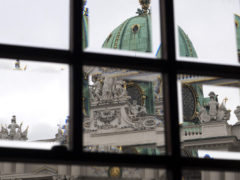
Vienna culture: discover the city’s most fascinating era
Early last century, Vienna was home to some of the most avant-garde artists and architects in history. (more…)...
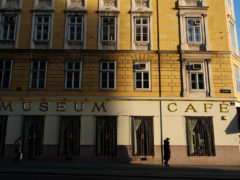
7 ways to see Vienna like a true 20th-century artist
The fin-de-siècle period was an incredible time for modern art, design and architecture in Vienna and its zeitgeist is very much alive today. The cit...
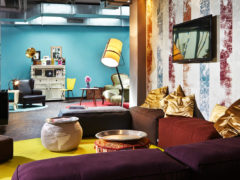
Review: 25hours Hotel Vienna
A riot of colour and vintage and clever ideas, this could be one of the quirkiest sleeps you’ll ever have. Jennifer Pinkerton runs away to the circu...

Vienna's Ringstrasse
The world’s most beautiful boulevard is home to many of Vienna’s most famous sights and museums, as well as grand palaces and spacious parks.
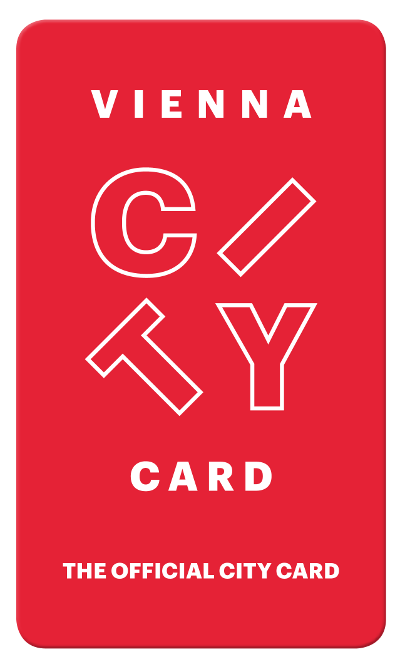
Vienna City Card
Vienna's ringstrasse.
Vienna's Ringstrasse is 5.3 kilometers long. Long enough to provide space for numerous monumental buildings, which were built during the period of ...
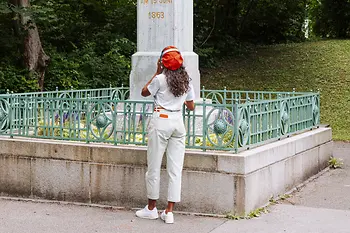
Discover the Ringstrasse with ivie's audio walk
Vienna's magnificent boulevard is ideally suited for a city walk. The app ...
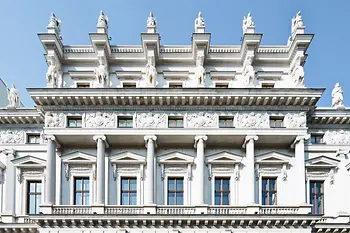
Ringstrasse Palaces
The construction of the Ringstrasse also entailed several magnificent ...
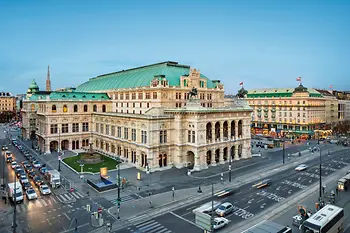
The most important building on the Ringstrasse boulevard
Ringstrasse is lined by Austria’s most important buildings: an overview
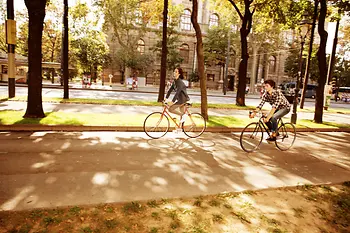
The best bike tours through Vienna
Exploring Vienna by bike brings a breath of fresh air to the usual daily ...
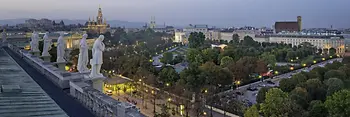
The origin of the Ringstrasse
The construction of Vienna's Ringstrasse was a masterpiece in terms of urban planning. Building works lasted for more than half a century. Today the ...
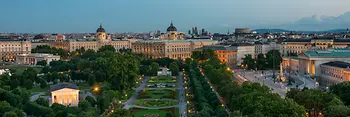
Ringstrasse tour
You can experience the most beautiful boulevard in the world on foot or on board of a tram.

The construction of Vienna's Ringstrasse was a masterpiece in terms of urban ...

You can experience the most beautiful boulevard in the world on foot or on ...
Filter results
[An * means an affiliate relationship; see footer] City guide | Search the site | April tips
Visiting Vienna
Walking tour: the Ring
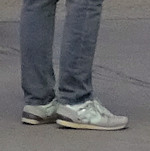
Part 3 of our walking tour of Vienna leaves the Hofburg and wanders along a section of the giant Ringstrassen boulevard with its parks, museums, and important civic buildings.
Continue reading for route info, special tips, details on the main locations you walk past, plus some information on guided options.
- If you keep moving, the 4-part route takes around 1½ hours
- Book a guided tour * for your visit
- Vienna tours overview
The Ring route
We ended Part 2 of the tour by leaving the Hofburg complex through the monumental Burgtor entrance. Ahead of us is the Ring boulevard that encircles the heart of Vienna.
But before we get to the Ring itself and all the wonders it holds…
The Burggarten
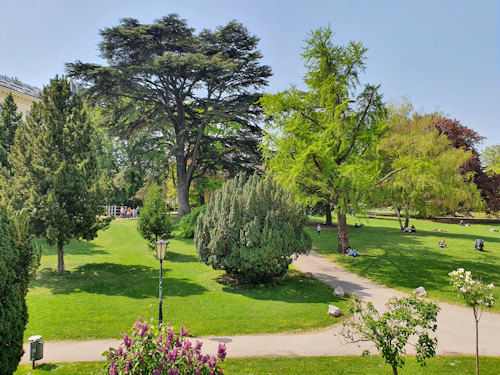
(The Burggarten park)
Instead of going through the Burgtor, consider first walking left, which takes you around the end of the Neue Burg (the wing of the Hofburg that’s been on your left as you crossed Heldenplatz square).
The rear of the Neue Burg has the rather nice Burggarten park , created on land made unexpectedly available for development in the early 1800s; Napoleonic troops used the fortifications that previously stood there for ballistics practice.
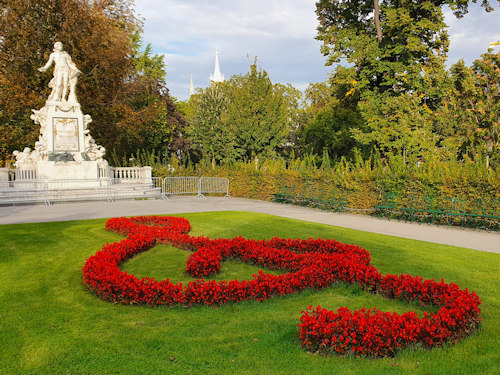
(A floral tribute to a musical genius)
The corner of the Burggarten you emerge into has the popular Mozart monument with (in the right season) its treble clef flower bed.
(The opposite corner of the Burgarten takes you to the Albertina art museum from an earlier part of our tour.)
After saying hello to Wolfgang Amadeus, retrace your steps and walk under the Burgtor and toward the large road that crosses in front of you.
On to the ring
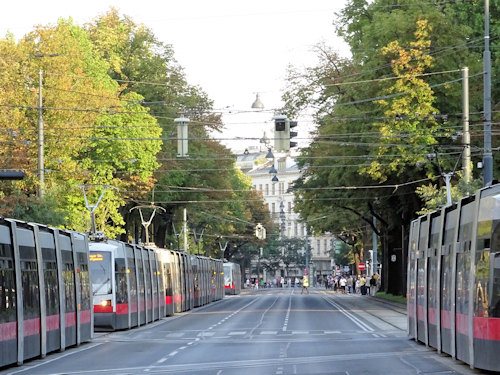
(Looking along The Ring)
That road is a section of the mighty Ring : an unmistakable continuous series of roads built after the city’s outer fortifications came down in the mid-1800s.
The Ring follows a similar path to the old city walls; the authorities sold some of the real estate flanking the open boulevard and used the rest for colossal urban development projects.
As a result, many stylish 19th century townhouses and monumental public buildings line the route. We shall walk part of the Ring clockwise to take in some of the best sights.
(If you walk in the other direction, you eventually find yourself back at the Staatsoper where our tour began .)
Museums & Maria Theresa
Turn right onto the Ring’s pedestrian paths. These sometimes cross or join cycle routes so keep an eye out for two-wheeled traffic.
Which side of the Ring you walk along depends on how close you want to get to different attractions, and you may find yourself swapping sides as required. But start off by crossing the road to reach our first Ring stop.
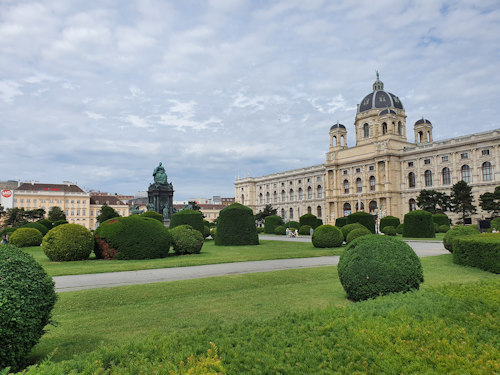
(The building on the right is the Naturhistorisches Museum)
Maria-Theresien-Platz is a landscaped square immediately opposite the Burgtor with two large museums facing each other and a giant monument in the centre.
The museum on your left as you look at the square from the road is the 1891 Kunsthistorisches Museum (KHM) building, full of art treasures from the past. The interior decoration is an artwork in its own right (some of it done by Gustav Klimt).
The museum on your right is the 1889 Naturhistorisches Museum (NHM) building: Vienna’s Natural History Museum and equally magnificent inside as its twin opposite.
Inevitably, the NHM is a top location for entertaining kids , not least due to its dinosaurs and interactive displays. Strangely, the museum also has two of Vienna’s most notable artistic treasures: the Venus von Willendorf and the Gemstone Bouquet .
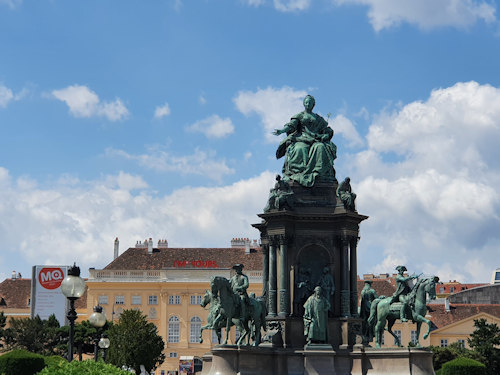
(Maria Theresa looks out over her former dominion)
The large 1888 monument is to Empress Maria Theresa (1717-1780), whose accession to the various Habsburg thrones ruffled a few male feathers and led European competitors to try and muscle in on her territories.
Unfortunately for our affronted masculine nobility, the Empress proved a remarkably successful leader. The statues and reliefs around the monument represent key personalities from her reign. See if you can spot Haydn and Mozart, for example.
Monument of the Republic
Stay on this side of the Ring and walk past the end of the Natural History Museum to discover the Monument of the Republic.

(Monument to the first Austrian republic; we live in the second one, established after WWII)
This commemorates the proclamation of the first republic on November 12th, 1918, immediately after the end of WWI, which also saw the demise of the ruling Habsburg monarchy .
The busts are of three key politicians behind that process:
- Jakob Reumann (a future mayor who also played a key role in Vienna’s legendary social housing initiative)
- Ferdinand Hanusch (a prime mover behind the development of worker-friendly social policies)
- Viktor Adler (the acknowledged founder of the Austrian social democracy movement)

(Athena guards the front of parliament)
Rather appropriately, walking past the monument brings you to Austria’s Hellenic-style working parliament building from the early 1880s.
Parliament has just reached the end of a huge renovation programme, so what you see is remarkably pristine for a building that’s almost 150 years old.
You can take a tour (free and in English) of the interior architecture and visit a public café or restaurant inside.
By now, you’ll have worked out that all those old-looking buildings along the Ring “only” date back to the second half of the 1800s.
Architects of the time and (more importantly) the people who financed their projects largely favoured the historicism approach, where you design new buildings to match old architectural styles. Then along came Vienna Modernism to mix things up a little.
The Volksgarten
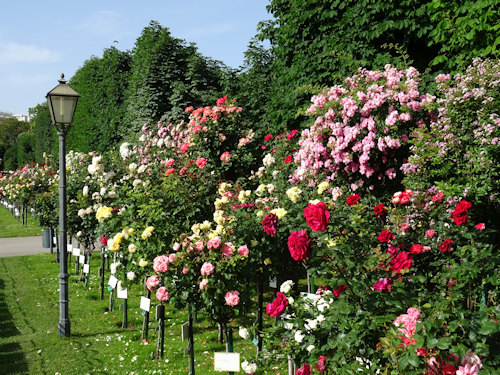
(The rose garden)
Opposite parliament on the other side of the Ring is the 1823 Volksgarten , another park that owes its existence to the destructive departure of Bonaparte’s troops from Vienna. Thanks, Napoleon!
The long stretch of the park that lines the Ring has more roses than a bumper pack of Valentine’s Day cards. The blooms from hundreds of varieties create a blaze of colour in late spring and early summer.
The Rathaus

(The tallest tower of the Rathaus)
Continue past Parliament to reach another more conventional park (the Rathauspark) and city hall: the neogothic 1883 Rathaus , whose central tower peeks through the trees as you approach.
Always keep on eye on the square (the Rathausplatz ) in front of the Rathaus. This location often hosts big events, such as an open-air film festival through summer, the huge Christkindlmarkt Christmas market (no prizes for guessing when this takes place), and an ice skating extravaganza in late winter.
The Burgtheater

(The Burgtheater seen from the Rathausplatz)
And our final stop on this Ring part of the walking tour is the 1888 Burgtheater opposite the Rathausplatz.
This is essentially Austria’s national theatre. The institution itself dates back further than the relatively new Ring-side premises.
Despite the theatrical tradition, the Burgtheater has its own special place in art history, since its staircase frescoes feature early works by none other than Gustav Klimt. You can see his efforts on one of their guided tours .
The Burgtheater marks the point where we veer away from the Ring to return to the old town in Part 4 of our walking tour: old Vienna and the cathedral .
- Top Destinations
- Mexico City, Mexico
- Tokyo, Japan
- Paris, France
- Rome, Italy
- London, United Kingdom
- All Destinations
- Upcoming Experiences
- Walking Tours
- Small-Group Tours
- Tours for Kids
- Museum Tours
- Food, Wine and Market Tours
- Newly Added Tours
- Audio Guides
- Pre-Trip Lectures
- Admin Dashboard
- My Favorites
- Client Orders
- Monthly Commissions
- My Advisor Profile
- Advisor Toolkit
- Guide Dashboard
Credit Balance
Transactions are based on current exchange rates and performed in USD. There maybe slight variations in the price estimates.
Discover Vienna's Glorious Ringstrasse: A Walking Tour Back Through Time

Experience the remarkable history of Vienna as you stroll the Ringstrasse with a Context Expert
Vienna’s prestigious and visually arresting Ringstrasse (Ring Road) offers one stunning building after another – from the Vienna State Opera to the Kunsthistorisches Museum, there’s no other street like it in the world.
Built in 1865, after the city's medieval fortifications were dismantled, construction of the Ringstrasse signaled a significant expansion of Vienna's urban area. The Ringstrasse is lined with some of Vienna's most important and impressive buildings and is home to many luxury hotels, cafes, and shops. This impressive avenue is also recognized as a UNESCO World Heritage Site.
Because there is so much history to take in when you visit Ringstrasse, you’ll get the most profound experience if you take a Ringstrasse guided tour . A local cultural historian or scholar leads our private outdoor walking tour, providing essential context and insights into Vienna’s history and culture.
The Ringstrasse Tour Experience
Our Ringstrasse private tour allows you to immerse yourself in the luxury and history of this fabled street, guided by a local expert. During your tour, you’ll look at this hallmark of Vienna’s urban landscape through the eyes of the prominent families who once lived, dined, and socialized here. As you wind along the street, stopping at striking venues and cafés, you’ll gaze up at the Ringstrasse's palaces and imagine life in the affluent households of 20th-century Vienna.
Your journey will start at the magnificent Palais Coburg, which retains parts of the old city wall. The removal of the former city defenses paved the way for the palaces and promenades we see today, including this one, with its stunning façade of gleaming white columns.
You’ll then see notable buildings such as Palais Erzherzog Wilhelm, named for the eponymous archduke of the Habsburg dynasty, Palais Königswarter, the address of Emperor Franz Joseph's lover, Katharina Schratt, and Palais Todesco, where you’ll discuss the importance of Jewish families in Vienna—an important theme throughout the walk. If time permits, you might be able to jump on one of Vienna’s iconic trams to ride the entire length of the historical thoroughfare and experience these grand buildings from a new perspective.
At the end of your tour, you’ll leave not just with a deep appreciation of the singular structure and architecture of the Ringstrasse, but also a nuanced understanding of Vienna's fascinating societal and cultural evolution.
Opulence and Elegance on the Ringstrasse
A stroll along the Ringstrasse conjures the image of Vienna's high society – gilded buildings, luxurious parties, cultural gatherings, and the quintessential social intrigue that characterizes the affluence of the Gilded Age.
While each carefully designed and constructed building on the Ringstrasse deserves attention, these are some of the most beautiful architectural masterpieces in Vienna, and you can see these notable buildings on the Ringstrasse on our guided tour.
Palais Coburg
The Palais Coburg was built between 1840 and 1845 as a palace for Prince Ferdinand of Saxe-Coburg and Gotha, and it has since been used for various purposes, including as a hotel and a center for cultural events.
The building is known for its distinctive neoclassical style, characterized by its grand facade, elegant columns, and ornate decorations. The palace is equally impressive inside, featuring a beautiful courtyard, luxurious guest rooms, and a stunning wine cellar.
In recent years, Palais Coburg has become known as a top destination for wine lovers, as it is home to one of the most extensive wine collections in the world. The wine cellar in the palace's basement contains over 60,000 bottles of wine from all over the globe, including rare vintages and unique blends.
Palais Erzherzog Wilhelm
Palais Erzherzog was constructed in the 19th century for Archduke Wilhelm Franz Karl of Austria, and it embodies stunning neoclassical architecture.
The palace features a grand entrance, elegant columns, and beautiful sculptures, all reflecting the opulence and grandeur of the Austrian monarchy during the 19th century. The palace’s interior mirrors the extravagance of the exterior, with spacious rooms, ornate decorations, and beautiful frescoes on the ceilings.
Though it previously served as a private residence for the Archduke, it is now open to the public. The Palais Museum, located on the first floor, contains a variety of exhibits related to the history and culture of Vienna. Visitors can explore the museum's various rooms, decorated with period furnishings and artwork, and learn about the city's rich cultural heritage.
Palais Königswarter
Widely considered to be a gem of Vienna, Palais Königswarter was originally built for the Königswarter family, who were prominent members of Viennese high society. The palace’s unique architectural style blends elements of the Gothic and Renaissance periods.
This palace’s exterior is just as interesting as the societal scandals that infuse the building too. Baron Miklós Kiss de Ittebe purchased the home from the Königswarter family, and the Baron’s ex-wife, Kartharina Schratt, inherited it when he passed. Schratt was long rumored to be Franz Joseph’s lover. Some believe that he actually gave her the home as a present – one of the great mysteries of Vienna's history!
Palais Todesco
Palais Todesco features a large central hall adorned with amazing frescoes and sculptures, as well as high ceilings and exquisite furnishings. Throughout its history, Palais Todesco has been a private residence, a center for cultural events, and the headquarters of the Bank of Austria.
Today, Palais Todesco is a popular venue for concerts, conferences, and other special events. Its central location, stunning architecture, and rich history make it a must-see destination for anyone interested in Vienna's cultural heritage.
An Era of Prosperity on the Ringstrasse
The Ringstrasse is more than an avenue of beautiful buildings. It is a formidable symbol of Vienna’s modernization and emergence as a political power.
Who built the Ringstrasse?
Franz Joseph I, an Emperor of the Austro-Hungarian Empire, was largely responsible for the construction of the Ringstrasse area. Work began in the 1850s and continued for nearly 40 years.
The Ringstrasse was built during the mid-19th century, a time when Vienna was the capital of the Austro-Hungarian Empire, one of the most powerful political entities in Europe at the time. The masterpieces on the Ringstrasse serve as a reminder of Vienna's political importance, with many of its grand buildings housing the offices of government ministries and other institutions.
The construction of the Ringstrasse also coincided with the growth of Vienna’s new middle class of professionals, businessmen, and upwardly mobile individuals. This beautiful landmark provided a front-row seat to the explosion of wealth and status. It also signaled the start of a broader effort to modernize Vienna.
The new boulevard was designed to accommodate the latest forms of transportation, including horse-drawn carriages and, later, electric trams. The Ringstrasse also incorporated many modern technologies and materials, such as iron and glass, in its construction.
How Long Does it Take to Walk the Ringstrasse?
Vienna’s Ringstrasse stretches for just over three miles (about 5 kilometers). We recommend that if you’re traveling at a leisurely pace, you allow at least three hours to experience the spectacles that line this famous avenue.
Why Take a Tour of the Ringstrasse
While many simply walk along the Ringstrasse and take in its glorious buildings, don’t miss an opportunity to enhance your experience with a guided tour . It is a place meant to be discussed, analyzed, and fully appreciated.
You’ll get to connect with a local expert who can offer unique insights and customized expertise on this amazing location. Your local historian guide can highlight the most significant parts of each building and help you navigate this historic street steeped in Vienna history.
A deeper understanding of the Ringstrasse and its place in Austrian history offers key context into Austria's cultural identity as a whole. You’ll depart your tour with a new appreciation for the people who once lived inside these storied buildings and had a significant role in designing Vienna’s next century.
If you are planning a trip to Vienna, take some time to peruse our additional Vienna guided tours . Our local experts offer in-depth, exciting tours and experiences designed to enhance your time in Austria.
Read More Stories

Even More from Context
Subscribe to our Newsletter
Keep Exploring

Upcoming Seminars
See full schedule
Explore Tours
Join walking tours with top experts all over the globe.
Browse Our Cities
- Our Experts
- Working with Context
- View All Cities
- Sustainable Tourism
- Refer a Friend for $50
- Travel Updates
- Advisor Login
- Expert Portal
- Privacy Statement & Security
- Cancellation Policy
Our website uses cookies to personalize your experience, perform analytics, and tailor ads. By clicking accept, you consent to our use of cookies. To view our data privacy policy, click here .
Our website uses cookies to personalize your experience, perform analytics, and tailor ads. By using our site, you consent to our use of cookies. To view our data privacy policy, click here .

- What to see
Monuments and attractions
Ringstrasse.
The Ringstrasse boulevard is the most important street in the city , built where the walls of the old Medieval city were located. It is home to some of Vienna's most iconic buildings.
The Ringstrasse is a circular boulevard that surrounds Vienna's historical centre , separating the Hofburg and Stephansdom districts from the rest of the city. It is home to a large number of the city's most symbolic architectural works .
A brief history
Vienna was protected by fortified walls from the 13th century until 1850, when houses started to pop up outside the walls. In 1857, to create more space for the city, the demolition of the ancient walls began, and in its place the beautiful Ringstrasse boulevard was built.
The magnificent buildings that line this boulevard include the Hofburg Palace , the Rathaus, the Stock Exchange, the Parliament , the Burgtheater, the Votivkirche, the University, the Art History Museum and the Natural History Museum .
Sections of the Ringstrasse
The Ringstrasse is divided into different sections of road which form the ring around the city : Stubenring, Parkring, Schubertring, Kärntner Ring, Opernring, Burgring, Dr. Karl-Renner-Ring, Dr. Karl-Lueger-Ring and Schottenring.
A delightful walk
Ringstrasse is one of the most beautiful streets in the city , and the location of many of Vienna's most important tourist attractions. If you don't fancy walking down the boulevard, another option is to explore it by tram .
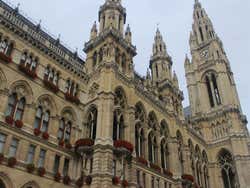
Surrounding the city's Old Town.
Nearby places
Vienna Natural History Museum (149 m) Vienna Art History Museum (164 m) Hofburg Palace (333 m) Austrian Parliament Building (386 m) Austrian National Library (402 m)
You may also be interested in
Discover Vienna's most iconic monuments and the tourist attractions that you don't want to miss on your trip to the Austrian capital.
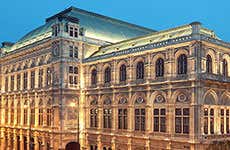
Vienna State Opera
Discover why Vienna's Staatsoper is one of the most famous opera houses in the world. Learn all about the State Opera and how to visit it.

IMAGES
VIDEO
COMMENTS
Next on your walking tour of Ringstrasse is Burggarten. It's just a three-minute walk from the Vienna State Opera, across one block and Operngasse. Once part of the glacis in front of the Vienna City Wall, Burggarten is now one of Vienna's most charming parks. Route and distance from Vienna State Opera to Burggarten.
Here are four reasons why exploring Vienna's Ringstrasse is a walking tour experience like no other: Marvel at the overwhelming 19th-century architecture that showcases the opulence and elegance of the era. Take short breaks in spacious gardens adorned with marvelous flower arrangements and statues, offering a serene oasis amidst the bustling ...
Viennese Ringstrasse - Ring Road. The Viennese Ringstrasse surrounds circular the 1st district in the center of Vienna.The multi-lane street was built as a boulevard instead of the demolished city wall in the middle of the 19th century.The emperor at that time, Franz Joseph I., gave the order for this.As a result, many new magnificent buildings were built around the Ringstrasse.
The Ringstrasse is a 5.3 kilometer (3.3 mile) long circular road that completely encircles the city center of Vienna. Built in the mid-19th century, this grand boulevard replaced and was designed to replace the old city walls, giving Vienna its modern appearance today.
Ringstrasse Tram Tour Overview: The 3.2-mile-long Ringstrasse (Ring Road) looping around Old Town Vienna traces the path of the impressive Medieval wall that once protected the city. The Medieval wall was completed in 1257 as an expansion outward to accommodate the flourishing trade town.
Walking guide to Vienna's famed Ringstrasse. The iconic Ringstrasse in Vienna, Austria. Photo by Christian Stemper. One of Europe's most masterful boulevards, Vienna's famed Ringstrasse celebrates a distinguished milestone this year. Here, Quentin Long strolls past some of its most imposing structures and through 150 years of compelling ...
2024 marks the 150th anniversary of Arnold Schönberg's birth. 26 institutions are collaborating to present 129 events at 16 locations under the ...
Explore Vienna's iconic Ringstrasse and its stunning buildings on this guided walking tour. Learn about Vienna's cultural and societal evolution and the significance of the Ringstrasse in Austria's history. Discover opulent palaces, like Palais Coburg and Palais Erzherzog Wilhelm, and get a deeper understanding of Vienna's cultural identity. Book a Vienna guided tour today and enhance your ...
The 5.3 km-long Ringstrasse, the most impressive urban development project of the 19th century, has rightly turned Vienna into a global city.Countless myths and legends surround it. Here you can stroll in the footsteps of greats like Gustav Mahler, Sigmund Freud, Michael Jackson, Grace Jones, and Wes Anderson. ivie's audio walk leads you to the highlights along the Ring as well as to less well ...
Ringstrasse tour. You can experience the most beautiful boulevard in the world on foot or on board of a tram. The world's most beautiful boulevard is home to many of Vienna's most famous sights and museums, as well as grand palaces and spacious parks.
Part 3 of our walking tour of Vienna leaves the Hofburg and wanders along a section of the giant Ringstrassen boulevard with its parks, museums, and important civic buildings. Continue reading for route info, special tips, details on the main locations you walk past, plus some information on guided options. If you keep moving, the 4-part route ...
Small-Group Ringstrasse Walking Tour. 4. 3 hours. Free Cancellation. From. $125.00. Likely to Sell Out. Prague Small-Group Day Trip from Vienna. 67. 13 hours. Free Cancellation. From. ... Small-Group History Walking Tour in Vienna: The City of Many Pasts. 60. 3 hours. Free Cancellation. From. $125.00. Vienna Highlights Small-Group Bike Tour ...
Vienna: Walking Tour of the Historic Ringstrasse. The Ring is one of the most beautiful boulevards in the world. Built on the site of the former city walls, it is a unique ensemble of impressive architecture containing more than 900 buildings of representation, spacious gardens, and monuments.
Tour Vienna's famous Ringstasse with a historian as your guide. The Ring was conceived to dramatically demonstrate the city's cosmopolitanism and modernity. ... Guided tour Vienna's Ringstrasse: 3-Hour Walk with a Historian. Activity provider:insightcities.com. 4.5 / 5 2 reviews. From $125 per person. Check availability. Tour Vienna's ...
Explore Vienna's most famous boulevard, the Ringstrasse, on this 3-hour tour with a small group. Follow your guide to stroll along the well-known road, listening to tales of its history, construction, and importance to Viennese city life.
The Ringstrasse Tour Experience. Our Ringstrasse private tour allows you to immerse yourself in the luxury and history of this fabled street, guided by a local expert. During your tour, you'll look at this hallmark of Vienna's urban landscape through the eyes of the prominent families who once lived, dined, and socialized here.
The Ringstrasse boulevard is home to some of Vienna's most important architectural masterpieces and is the most important street in the city. ... If you don't fancy walking down the boulevard, another option is to explore it by tram. Rathaus, Vienna's City Hall ... Hitler's Vienna Tour. 9.78 27 reviews . US$ 28.10. book. Belvedere Museum ...
The Ring is one of the most beautiful boulevards in the world. Built on the site of the former city walls, it is a unique ensemble of impressive architecture containing more than 900 buildings of representation, spacious gardens, and monuments.
Vienna: Walking Tour of the Historic Ringstrasse 4.5 / 5 4 reviews Activity provider: Husa Travel Events View all 10 images Add to wishlist Guided tour Vienna: Walking Tour of the Historic Ringstrasse Activity provider: Husa Travel Events 4.5 4 reviews From US$ 285.23 per group up to 10. Book now ...
During the 3-hour guided walking tour of Vienna's Ringstrasse, participants can enjoy a personalized experience in a small group setting. This small group setting offers several benefits, enhancing the overall tour experience. Firstly, with a smaller group, participants can receive more individual attention from the knowledgeable guide ...
Numbers are limited to just 20 people. Guided walking tour of Vienna's Old Town. Pass the Hofburg imperial palace and learn of its history. Hear stories about the Empress Sisi and medieval knights. Check out the sights of the Ringstrasse such as Vienna City Hall. Walk through Volksgarten, known as the garden of a thousand roses.
The Vienna Ringstrasse Tourist Scavenger Hunt is a 4.4 km / 2.7 mi self-guided walking tour of the historic center of the city. It should take 3 hours to complete and ends near the start location.
A day of exploring in Vienna, the capital of Austria. In this video, you will see the most famous attractions in Vienna Austria including Stephansplatz, St. ...